FRANCKEN - ALLEGORY ON THE ABDICATION
OF EMPEROR CHARLES V IN BRUSSELS
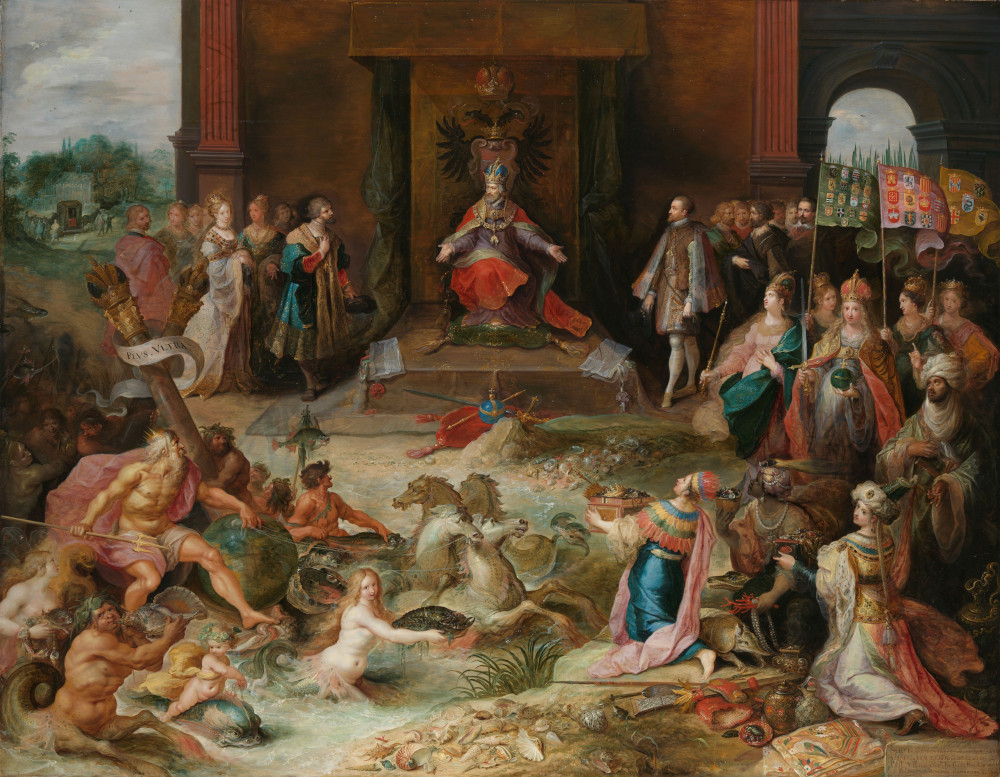
Frans Francken, Public domain, via Wikimedia Commons
1650
|
- Frans Francken the Younger's depiction of Charles V
(1500-1558), Holy Roman Emporer, in the allegorical act of dividing the entire world between Philip II of Spain and Emperor Ferdinand I.
- In 1556, Holy Roman Emperor Charles V divided his vast empire between his son Philip II of Spain and his brother Ferdinand I, who became Holy Roman Emperor.
-
This division led to the establishment of distinct Spanish and Austrian Habsburg branches and laid the groundwork for the political and cultural prominence of Spain.
|
In front of Philip the personifications of the
territories of the Empire with their banners are
kneeling down. In the foreground the personifications
of the continents, America, Africa, Europe and Asia,
are offering gifts.
(Wikipedia)
|
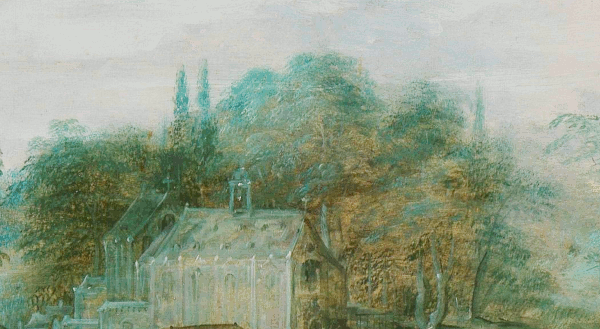
Division of lands |
- This act, depicted in an artwork, symbolizes Charles V's
abdication and the division of his lands.
- As Holy Roman emperor,
King of Spain, Lord of the Netherlands etc, he adbicated in the period 1554-1558 in several steps, dividing his enormous empire between his family.
- The painting shows the most famous of these abdications: the dividing of the German and Spanish lands.
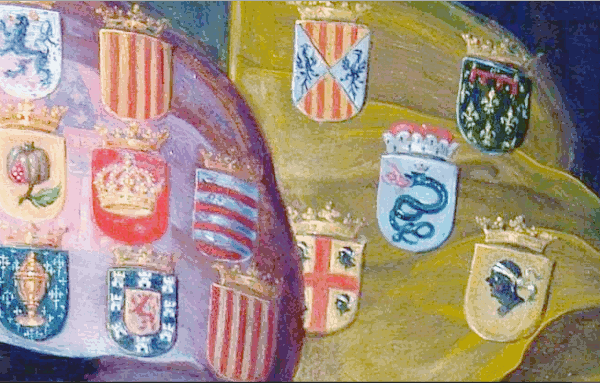
Flags represent the lands of Charles V |
- The female figures on the right with the flags represent the lands of
Charles V through their heraldry.
- The 4 persons bottom
right represent the continents over which Charles’s vast
empire stretched: (America, Africa, Europe and Asia) and
they are all dressed exotically and look very wealthy.
-
Bottom left we can see Neptune, along with mermaids,
seahorses, tritons etc.
-
Neptune represents the oceans, highlighting Charles V's
global dominion and his rule over the sea.
|
The personal union of the European and American territories he ruled was the first collection of realms labelled "the empire on which the sun never sets".
(Wikipedia)
|
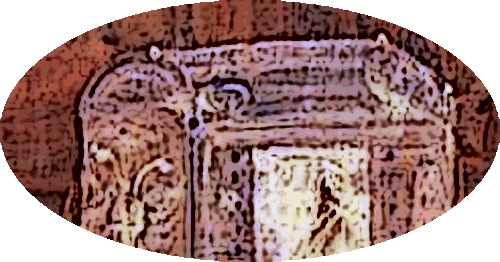
Monastery of Yuste |
- The motto of all of this is that all the lands pay homage to Charles V.
- One of the tritons carries a pillar with the line 'Plus Ultra'
which is Latin for 'further beyond.'
- This pillar is a part of the coat-of-arms of Charles V.
- Top left we can see a small house with a horse and cart.
- This is the monastery of Yuste in Extremadura where Charles
retired.
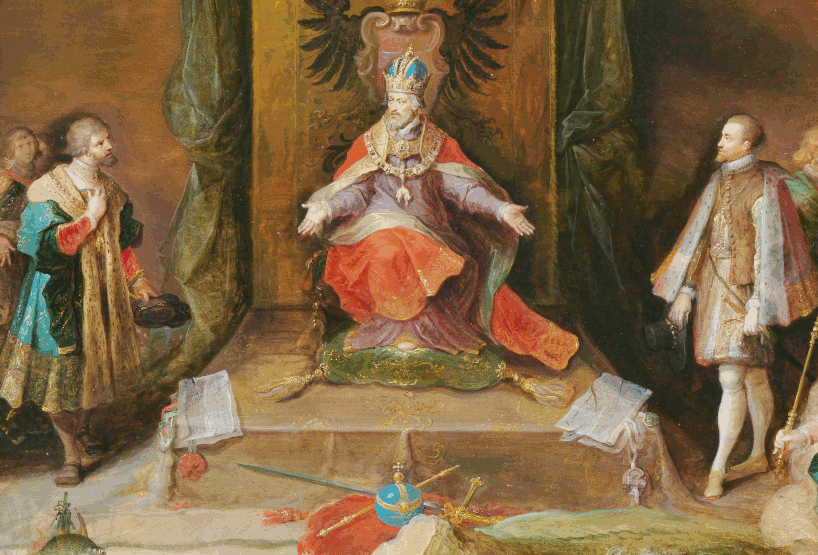
King and his successors |
- Charles V is seated on his 'thrown' flanked by his successors Ferdinand I and Philip II.
- He gestures to both Ferdinand (left) and Philip
(right), effectively handing over the reins of power.
-
Charles V is depicted as the world ruler.
|
"Let others wage war, but thou, O happy Austria,
marry; for those kingdoms which Mars gives to others,
Venus gives to thee."
(Mathias Corvinus)
|
|
The Foundation of Rome |
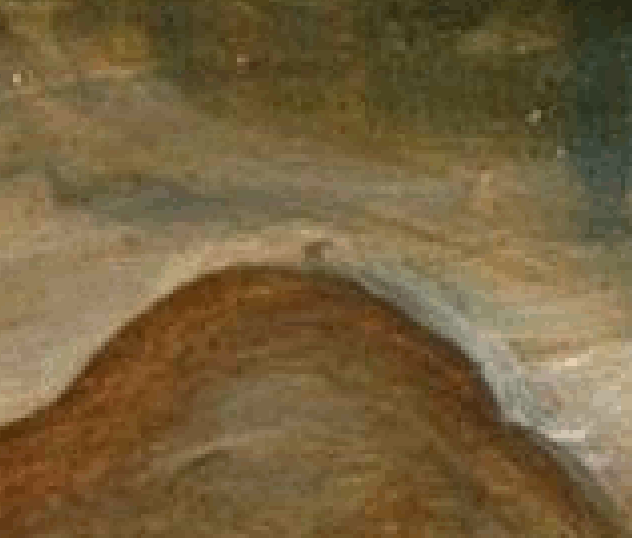
She-wolf arrives |
- Rome, and later the Roman Empire, is attributed to Romulus and Remus, twin brothers raised by a she-wolf, who founded the city on April 21, 753 BC.
- The Roman Republic later replaced the monarchy in 509 BC, and the Roman Empire emerged in 27 BC
when Octavian assumed power.
-
This Empire ruled the Mediterranean and much of Europe, Western Asia and North Africa.
|
While this is a legendary account, it's the accepted
date for Rome's founding, marking the beginning of the
Roman Kingdom. (Assistant)
|
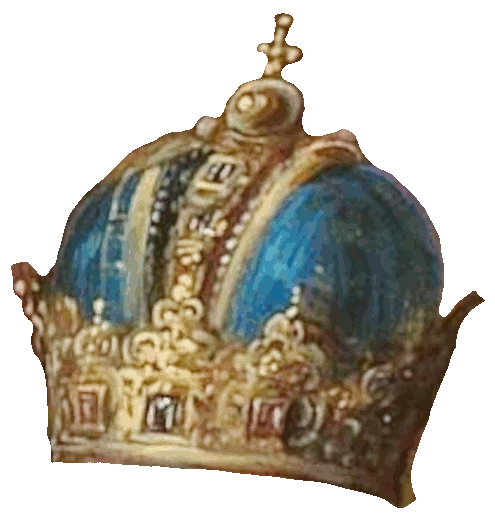
King monarchy |
-
Rome was ruled by kings, including Romulus, until the monarchy was overthrown.
- Beginning in 509 BC, the Roman Republic began a period of elected magistrates and a senate, expanding Rome's influence throughout the Italian peninsula and beyond.
|
By 100 BC, the city of Rome had expanded its rule from the Italian peninsula to most of the Mediterranean and beyond. However, it was severely destabilised by civil wars and political conflicts, which culminated in the victory of Octavian over Mark Antony and Cleopatra at the Battle of Actium in 31 BC, and the subsequent conquest of the Ptolemaic Kingdom in Egypt. In 27 BC.
(Wikipedia)
|
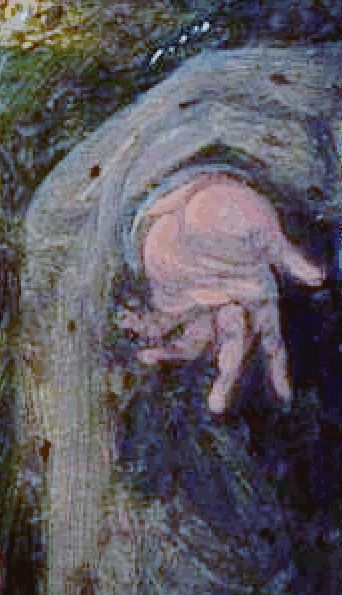
Taxes |
- Julius Caesar (100-44 BC) did not introduce taxes
and they were well-established going all the way back to the beginning of the Roman republic.
- If you were a Roman citizen, you
paid no taxes, instead, taxes were levied on the people of
conquered territories.
- As the empire grew and needed to
provide more services, taxes were voted by the senate that
applied to everyone.
- Caesar was the first to implement a sales tax: a 1
percent flat rate that was applied across the entire empire, under Caesar Augustus, the sales tax
increased to
4 percent.
|
There were taxes on land, there was a marriage tax, there was a tax to pay for the food needed by the horses of the public courier service, there was a tax to pay for the military, and on and on.
(Wikipedia)
|
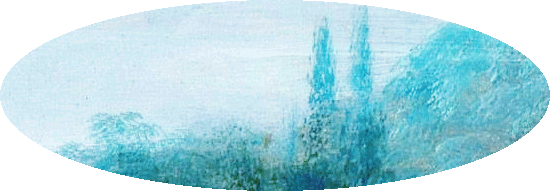
Vast empire |
-
The Republic eventually transitioned into the Roman Empire in 27 BC and Gaius Julius Caesar Augustus (63-14 BC),
also known as Octavian, nephew of the late Julius Caesar, became the first Roman Emperor, marking the beginning of the
Imperial period.
-
The Roman Empire expanded significantly, conquering vast territories and becoming a dominant power in the Mediterranean world.
|
And it came to pass in those days, that there went out
a decree from Caesar Augustus, that all the world
should be taxed.
(Luke 2:1)
|
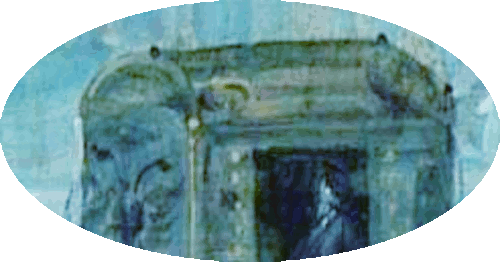
Manger |
- Caesar Augustus enacted the tax law where all citizens had
to return to their birthplace or origin to be taxed.
-
This earthly journey begins with Christ’s birthplace soiled and dictated by Roman despotism as Caesar Augustus.
-
Coming from the city of David where David defeated the
Philistines, Jesus knew the deep cruelty in Augustus law.
- Righteous kings enforced divine law, and wicked kings violated it.
|
Jesus witnessed firsthand the cruelty of Rome which tormented souls of young and old alike - think of the demon “Legion” (one of many) He cast into swine, which some theologians consider a purposeful, thinly veiled symbol of despotic Roman rule.
(John Sophocleus)
|
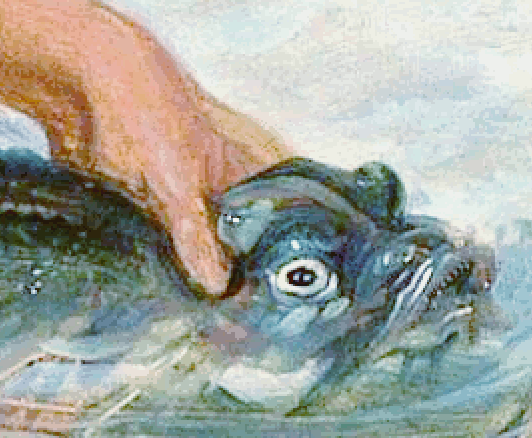
Quashed |
- This all started because issues of tax increases and royal appointments to the
Jewish High Priesthood that arose repeatedly throughout the Maccabees, always
associated with royal appointments and unworthy candidates.
- These Jewish officials combined the office of king and high priest in their own persons, violating the separation of religious and political authority established under
Judaism.
|
The Hasmonean priest-kings were also intolerant, slaughtering thousands of Jews who didn’t agree with them.
(Mark Silk)
|
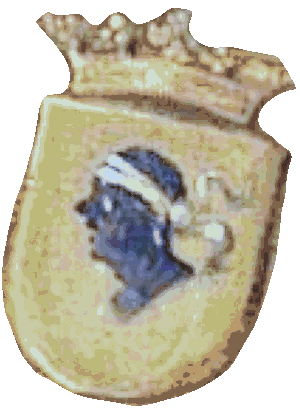
Civil war |
- But even deeper than that was that the country was
already split into two factions; the strict fundamentalists
who wanted law, and the more liberal minded.
- This was
the beginning of a civil war.
- Israel in those days was controlled by the king of Syria, known as Antiochus Da God.
- Seizing Jerusalem,
Antiochus decided to outlaw the practice of Judaism altogether, burning copies of the Torah, prohibiting observance of the Sabbath and holidays and forbidding circumcision.
|
As a result, a country priest named Mattathias and his
five sons instigated a revolt. These Maccabees, as
they came to be called, used guerrilla tactics to
defeat the Syrian army, recaptured Jerusalem and
rededicated the temple.
(Mark Silk)
|
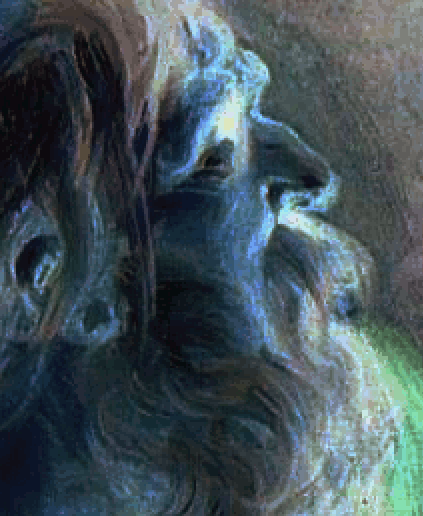
Statue of Zeus |
- Antiochus turned the temple into a Greek religious shrine, complete with a statue of Zeus.
- It was the Maccabean revolt that inspired the rebellion against the Romans some 170 years later, which led to the destruction of the temple and the exile of Jews from Judea.
-
In 66 AD, this discontent exploded in Judea into open rebellion
and four years later, the Roman army had crushed the revolt, but had also destroyed the temple.
|
The destruction of the Second Temple in Jerusalem by the Romans in 70 AD is a pivotal event in biblical history and is documented in both the New Testament and historical accounts.
(Assistant)
|
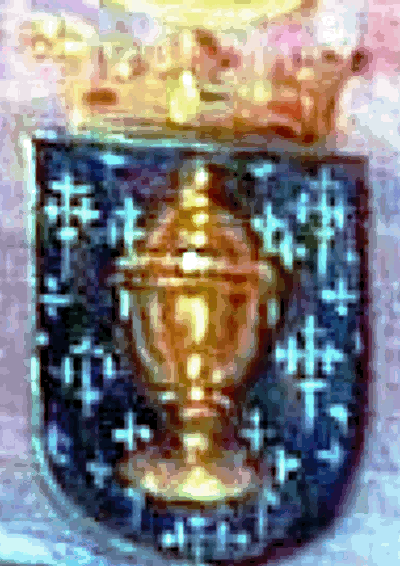
Sacred treasures |
- The sacred treasures were seized and shown off in a procession through the streets of Rome.
-The destruction of the temple fundamentally changed the nature of Judaism.
- Taxes that were once paid to the temple were now paid to Rome, and the Jewish tradition of worshipping in the temple was over.
- With only the Western Wall remaining of the temple in Jerusalem, the local synagogues now became the new centers of the Jewish religion.
|
These days, we may wonder whether the deeply flawed Israeli leader, Benjamin Netanyahu, is seeking to restore the Greater Israel of David and Solomon, and whether his government, well supplied with zealots, is motivated by secular or religious goals.
(Mark Silk)
|
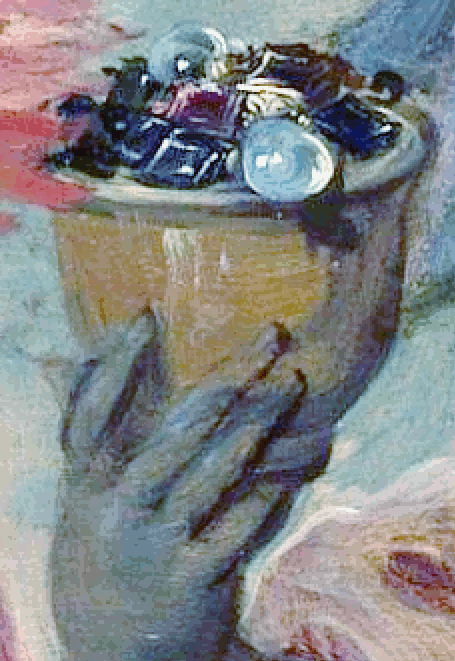
Tax methods |
-
Not surprisingly, the Romans also understood, taking great efforts to remove Menorahs, Stars and statues of David whenever they conquered the Jews, as known symbols of tax revolt.
- Showing that Jesus knew the antagonistic nature of the
Roman oppressors by their tax methods.
- These natives
didn't look poor back then.
|
The Seleucids’ attempt to control the appointment of the Jerusalem High Priests was indeed an innovation introduced by Antiochus IV, who exploited his appointees’ weakness—their lack of dynastic legitimacy—to extort sharp tax rises from them. Like all popular revolts in ancient times, its principal cause was the newly-imposed high taxes.
(John Sophocleus)
|

Crocodile |
-
In the Roman Empire, alligators and crocodiles were symbols of Egypt, especially after Rome's acquisition of Egypt in 30 BC.
- Crocodiles were also featured in Roman coins, often chained to a palm, symbolizing Roman victory and control over Egypt.
- They were also used in the Colosseum, where they were hunted in a pool as part of public entertainment.
|
395 AD |
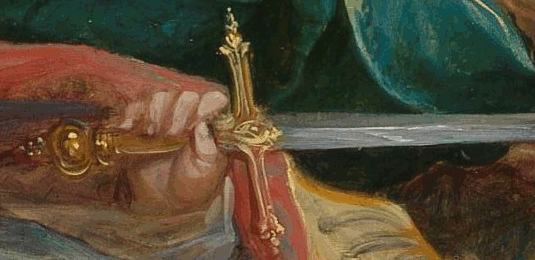
Split the Roman Empire |
- The split of the Roman Empire into Western and Eastern halves in 395 AD, followed by internal conflict between the two halves, weakened the Western Empire.
- The West was severely shaken in 410 AD, when the city of Rome was
invaded by the Visigoths, a wandering nation of Germanic peoples from the northeast.
- Historically, this event marked the transition between classical antiquity and the Middle Ages.
|
A kingdom of gold to one of rust and iron.
(Cassius Dio, Greek historian)
|
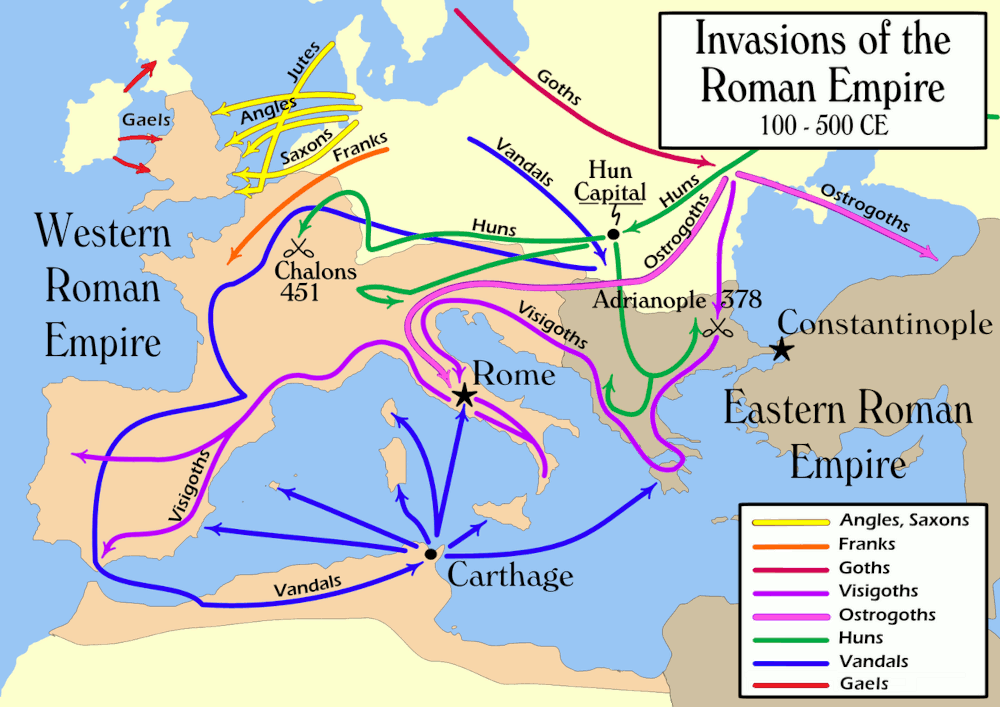
User:MapMaster, CC BY-SA 2.5 , via Wikimedia Commons
Invasions of the Roman Empire |
- The Western Roman Empire began to disintegrate in the early 5th-century.
- The Romans fought off all invaders including Attila, but the empire had assimilated so many Germanic peoples of dubious loyalty to Rome that the empire started to disintegrate.
-
These Barbarian invasions consisted of the movement of Germanic peoples into Roman territory.
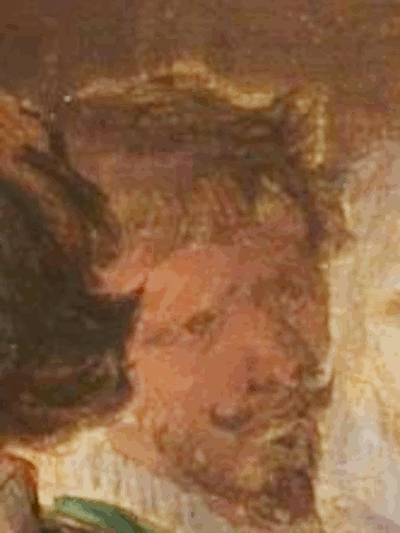
German
warlord Odoacer |
- The fall of Rome was completed in 476 AD, when the German chieftain Odoacer deposed the last Roman emperor of the West, Romulus Augustulus.
- The Western Roman Empire's fall was a result of a combination of internal and external factors, including political instability, economic woes, and barbarian invasions.
- The Eastern Roman Empire, also known as the Byzantine Empire, continued to thrive for another thousand years, continuing Roman traditions and influence until the fall of Constantinople in 1453.
|
Odoacer ended the Western Empire by declaring Zeno sole emperor and placing himself as Zeno's nominal subordinate. In reality, Italy was ruled by Odoacer alone.
(Wikipedia)
|
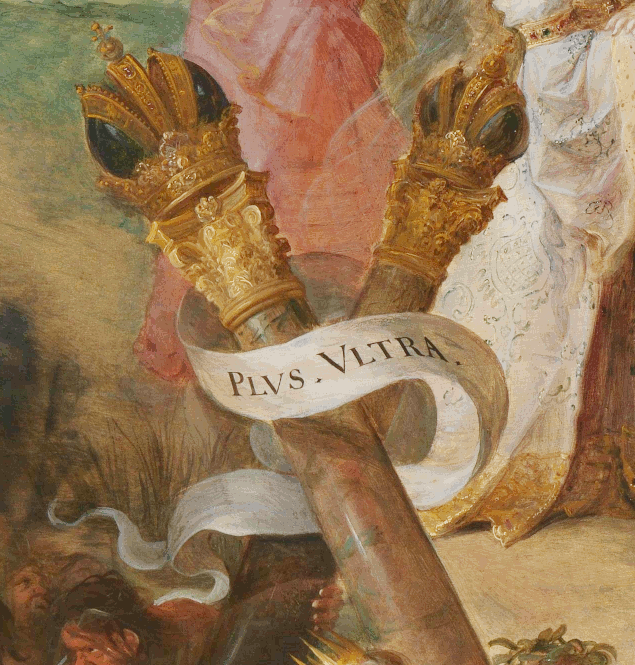
Plus Ultra |
- What remained of the original Roman Empire continued for centuries of ups and downs and eventually became divided into several competing realms.
- Plus Ultra means 'further beyond' and was the imperial
motto.
- For a brief period around 1355 to 1371 there were about
eight Roman Emperors in various parts of the empire.
|
Neptune is riding his seahorse-drawn Triumphal chariot, accompanied by mermen, mermaids, tritons, etc. On the chariot a globe and the two columns with a banderole inscribed with Plus Ultra.
(Wikipedia)
|
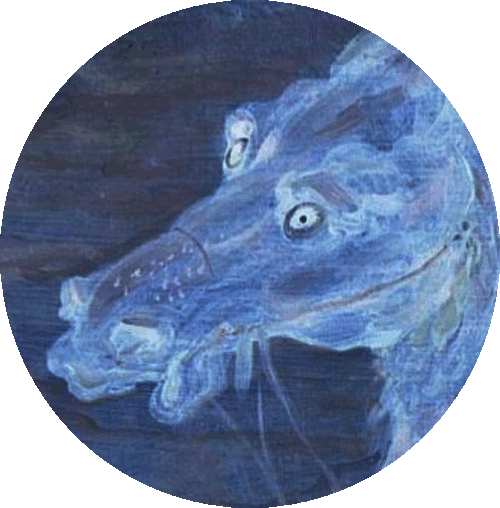 |
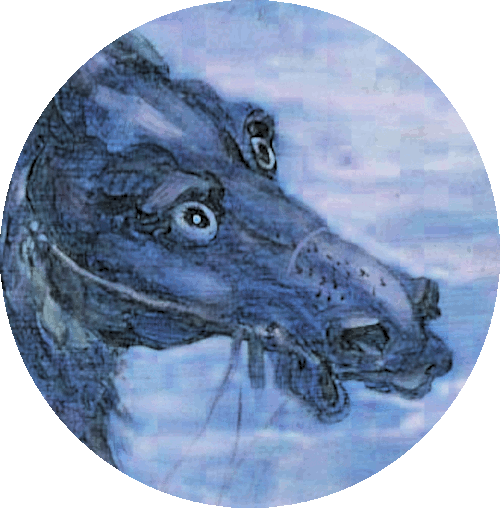 |
|
West |
East |
|
Pale horse riding now |
- After the collapse of the Western Roman Empire, the
Christendom that remained in the West was a scattered group
of rural warriors who used combat to promote conversion to
Christianity.
- The Catholic Inquistions killed millions
only the church wants to deny the charges but we've heard 50
million, 68 million and possibly a lot more.
- Inquisitions with the aim of combating religious sedition (apostasy or heresy) had their start in the 12th-century Kingdom of France, particularly
against the Cathars and the Waldensians
and later the Spanish Inquisition.
- Don't let
them lie to you and claim these were 'different'
Inquisitions, it was the same church that accomplished it
all.
|
Foundation of the Holy Roman Empire |
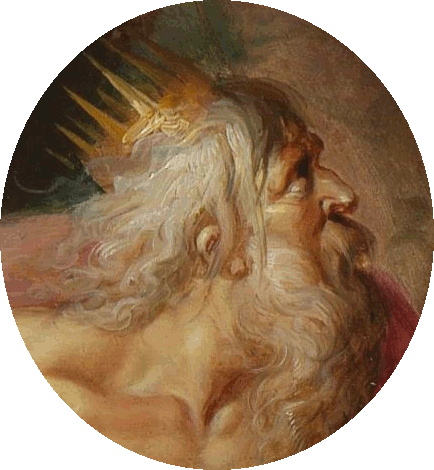
Priest or king |
- The Holy Roman Empire was traditionally seen as the descendant of the Carolingian Empire,
although several states claimed to be the empire's successor.
-
This was a polity that existed in Central and Western Europe for a millennium
beginning in 800 AD.
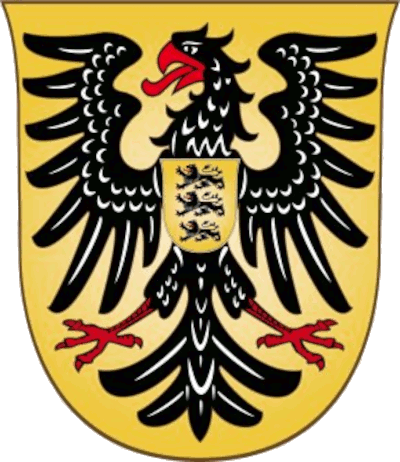
Editorial use favpng by
asalinas59
Holy Roman Emperor Holy Roman Empire
Germany Coat Of Arms Reichsadler |
- Charlemagne (742-814)
also known as Charles the Great, was crowned 'Emperor of the Romans' on a set of arguably flimsy
credentials by Pope Leo III.
- He was king of the Franks
and the Lombards and later became the Emperor of the
Carolingian Empire.
- His aunt married a watered-down
member of Christ's family
and then YHWH (Satan) gave the blessings.
- The Kingdom
on earth belongs to Jesus Christ, the firstborn son and was
usurped by Satan.
|
Byzantine in the East |
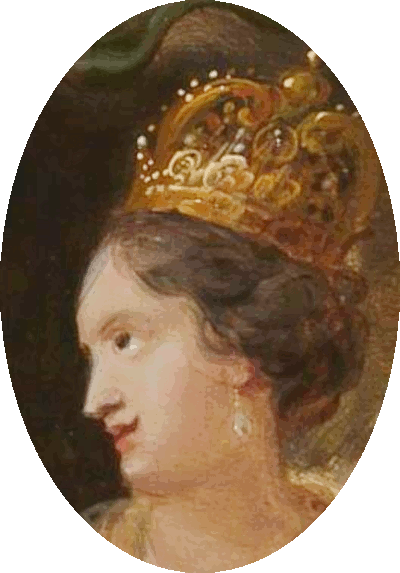
Good Night Irene |
-
At that same time, there was already an 'Emperor of the Romans' in Constantinople, but she was a woman
named Irene, and the
patriarchal Western church would not accept a female Roman Emperor.
- Irene of Athens (750-803) used the title 'Basileus' which means
Empress, instead of 'Basilissa' which means Emperor (King).
- She was Byzantine empress consort to Emperor Leo IV from 775 to 780.
- Later, she was regent during the childhood of their son Constantine VI from 780 until 790.
- Irene was co-ruler from 792 until 797, and finally empress regnant and sole ruler of the Eastern Roman Empire from 797 to 802.
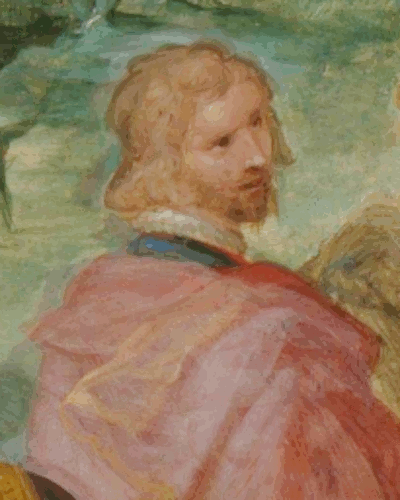
Constantine VI
the Blind |
- Constantine VI (771-803) was the only child of Emperor Leo IV
and Irene.
- He was named co-emperor with his father at the age of 5 in 776 and succeeded him as sole Emperor in 780, aged
9.
- After her husband's death, Irene secured the throne and
during her regency with her son Constantine, she became
very influential in government policies.
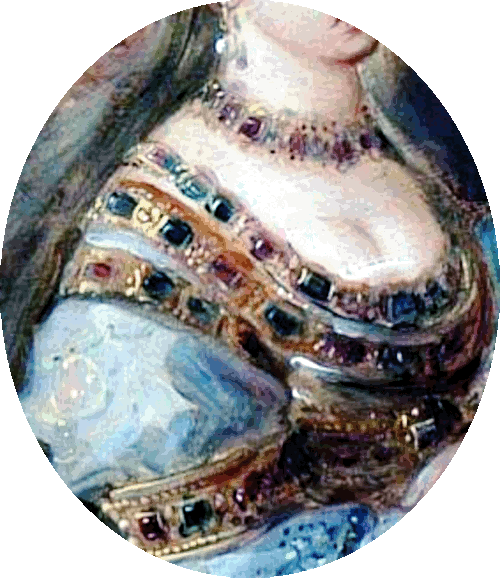
Irene as regent |
- Irene exercised control over
her son as regent until 790, assisted by her chief minister.
- The regency ended when Constantine reached maturity but
Irene had other plans.
- After a brief interval of sole rule, Constantine VI
named his mother empress in 792, making her his official
colleague and Irene reclaimed all imperial power as co-emperor with her
son.
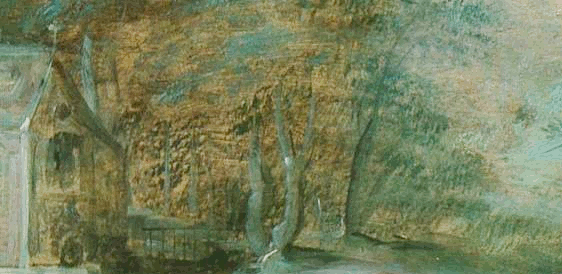
Constantine rebels |
- Over time, Constantine VI, who was eventually Byzantine emperor from 780 to 797,
in various roles, rejected his mother's influences.
- Several revolts took place in his attempt to take
over as
the sole ruler.
|
Constantine suffered military defeats and made controversial decisions, such as blinding his loyal general Alexios Mosele and illicitly marrying his mistress, Theodote.
(Wikipedia)
|
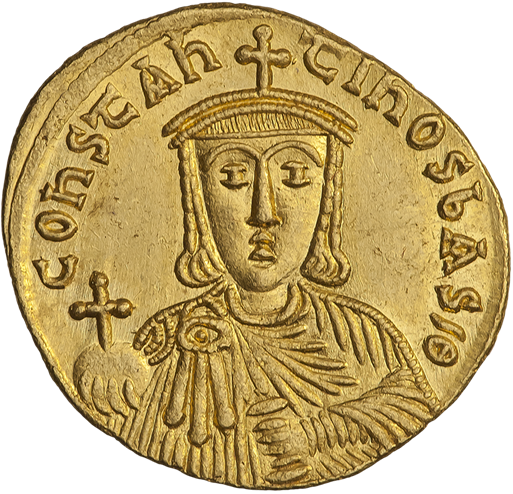
АНО "Международный нумизматический клуб", CC BY-SA 4.0 , via Wikimedia Commons
Constantine VI
solidus |
- Taking advantage of her son's unpopularity, Irene had Constantine deposed
and after a revolt, her supporters gouged out
her son's eyes and blinded him.
- Constantine was
imprisoned and presumably died shortly after.
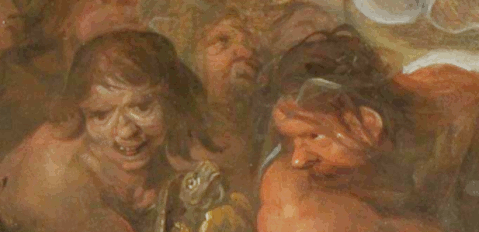
Revolt |
- There
does seem to be quite a bit of double standard concerning
how male rulers who lost their own family members in power
struggles are still revered, while the female ruler who's
accused of the same is vilified.
- Although not
condoning any of these royal families private wars.
- Roman society was extremely misogynistic and women in power are almost always portrayed negatively.
- It's also proven that Constantine VI was not a competant
leader although it's not clear if his power was suppressed
by Irene.
|
Especially unusual is that, while Constantine V was a militant iconoclast who was known for persecuting venerators of icons, Irene herself displayed iconophile predilections.
(Wikipedia)
|
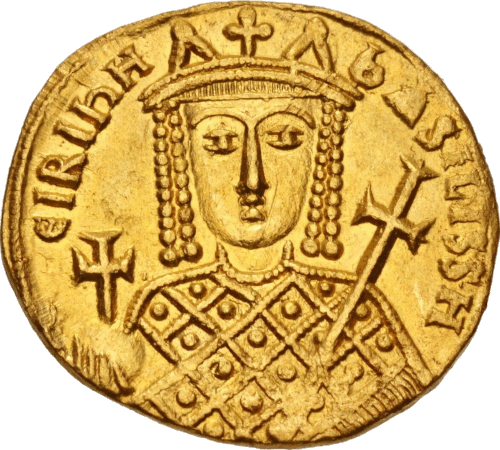
Classical Numismatic Group, Inc., CC BY-SA 2.5 , via Wikimedia Commons
Irene's solidus |
- Irene proclaimed herself sole ruler, but Pope Leo III,
already seeking to break with the Byzantine East, used
Irene's status as a female rule to name Charlemagne on
Christmas Day 800.
- This was using the pretext that a
woman could not rule, thus the Roman throne was actually
vacant.
- Irene of Athens is a saint and her feast day is August 9.
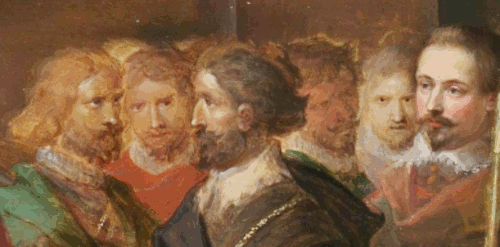
Rules and traditions |
- It was also felt that Charlemagne, as Emperor, was
intended to be the successor not of Romulus Augustulus (the
'last' western Roman Emperor) but of Constantine VI.
-
Irene ascended the throne after her son Constantine VI, so to the church,
this further legitimized the takeover by Charlemagne.
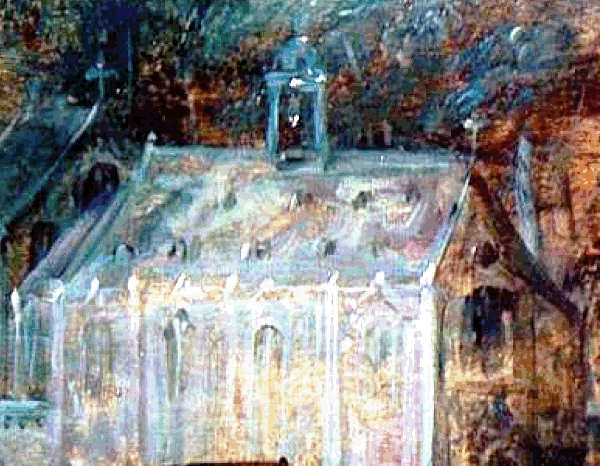
Church state |
- The growing rift between the Latin West and Greek East,
not only over issues of culture, but also of theology, and the rise of Iconoclasm in the East
was a significant factor.
- Irene had not been aligned
with the Pope and the church wanted a Christian monarch physically close to
Pope
Leo III.
|
Iconoclasm, meaning "image breaking" in Greek, refers to the destruction or rejection of religious images and other symbols, often for religious or political reasons. It's a recurring historical phenomenon, notably in the Byzantine Empire, and can also be understood as the act of opposing or challenging widely accepted beliefs or traditions. (Assistant)
|
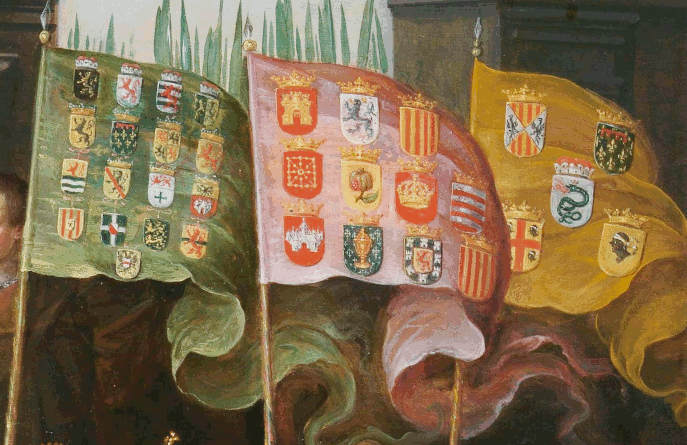
Independent states |
-
In principle, an empire is usually a singular state,
however, the Holy Roman Empire was a series of independent princedoms that existed as a loose confederation.
- The title of Emperor itself was an elected position, rather unusual for an
empire.
- To begin, even the idea of an 'Emperor' ruling was rooted in the Roman Empire,
it was their invention.
|
By Voltaire's time the "un-Roman-ness" of the Empire must have been fairly obvious. Italy, for example, had not been a part of the Empire for centuries. (skadefryd)
|
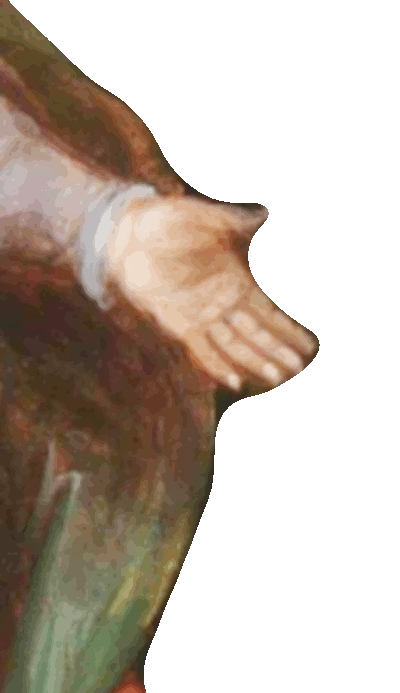
Ruling hand |
- The Holy Roman Empire's questionable claim to be the legitimate successor to Rome was a reason to doubt its status as an
empire, as well.
- Constantine VI was the final ruler to be recognized as Roman
Emperor, by both the
empire which he ruled in the
East, the Papacy, and the Western European powers over which the
Pope held
rule.
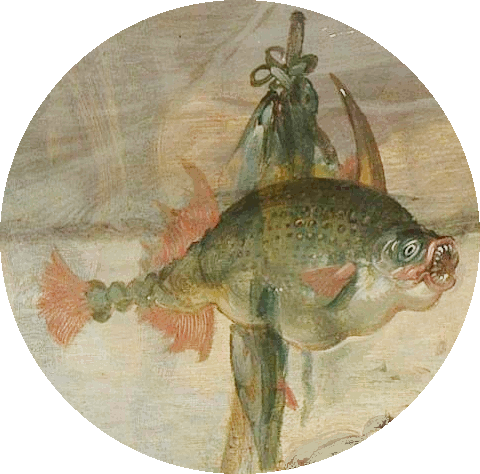
Fish out of water |
-The Byzantines' ability to protect the Papacy had faltered following the Arab Conquests, leading the
Pope to increasingly seek protection from the Germanic Franks.
-
As a result, Pope Leo III owed his power and position to the
Franks.
- Soon after the coronation of Charlemagne was
over, he
initiated marriage negotiations to unite the new Western and Eastern empires, thus resolving the problem of two emperors.
- Irene was happy to do so, but the proposal was frightening to some Byzantine civil and military officials.
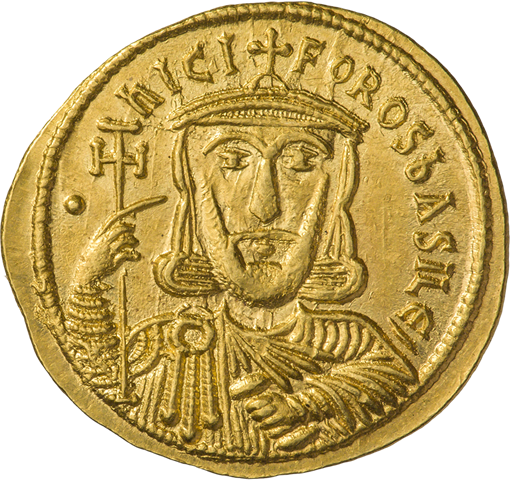
Nikephoros I |
- Not long after, Empress Irene in Constantinople was overthrown by an official who made himself Emperor Nikephoros I
(750-811).
- Nikephoros' co-conspirators informed
Irene's palace guards that she was forced to cede the throne, and that opponents of the coup wished to make Nikephoros emperor instead.
- The guards sided with Nikephoros, and the palace was surrounded.
- It is generally believed that Nikephoros I had a much better claim to be the rightful successor of Constantine VI
than Charlemagne.
|
He was General Logothete (finance minister) under Empress Irene, but later overthrew her to seize the throne for himself. Prior to becoming emperor, he was sometimes referred to as "the Logothete", in recognition of his previous role as General Logothete.
(Wikipedia)
|
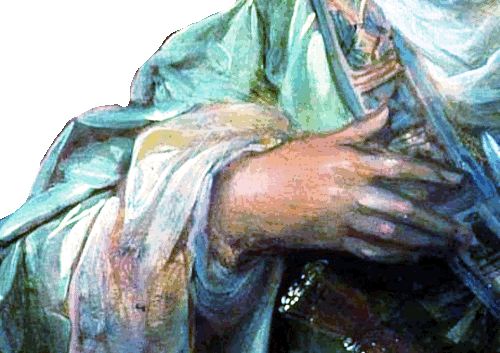
Longstanding traditions |
- Charlemagne recognized that the church's literate
hierarchy and traditions were the best instruments to defeat
the feudal lords who were battling each other
- Leo III
and Charlemage struck a deal where Charlemagne would receive all
the authority and tradition of the Caesars, and he would
acknowledge the church's superiority over his secular power.
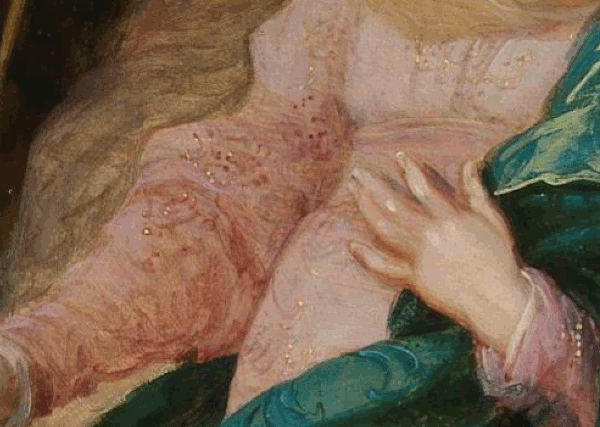
Dynastic marriages |
- In the centuries that followed Charlemagne, one European
warrior clan, the House of Habsburg fought to claim the
Emperor's throne, and to establish dominance over the
Papacy.
- One of the tactics the Habsburgs used was to
promote dynastic marriages between Habsburg cousins, thus
keeping inheritances within the family and away from the
church.
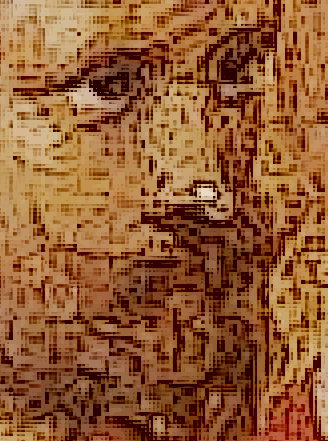
Recessive family gene |
- The Habsburg in-breeding worked very well politically, but
over the centuries, it brought out recessive family genes
for mental illness.
- Most famously, the oversized lower
jaws that became Europe's most recognized royal profile and
not a very attractive one.
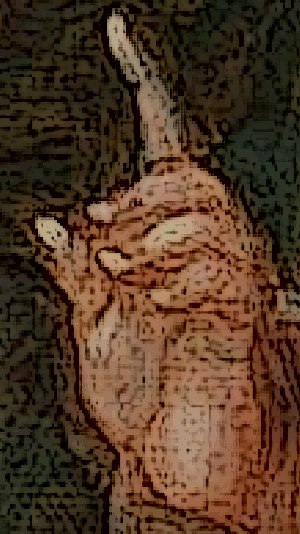
Winning support |
- The Papacy fought back and in 1356, the position of
Holy Roman Emperor was converted to an elected position,
instead of inherited.
- Candidates for the crown were
required to win support from at least 4 of the 7 electors.
- This didn't stop the Habsburgs from reclaiming the throne,
but it did force the family to pay fortunes in bribes and
favors to win it.
- Charles V won enough votes to become
a 16th-century Emperor.
|
Charles V |
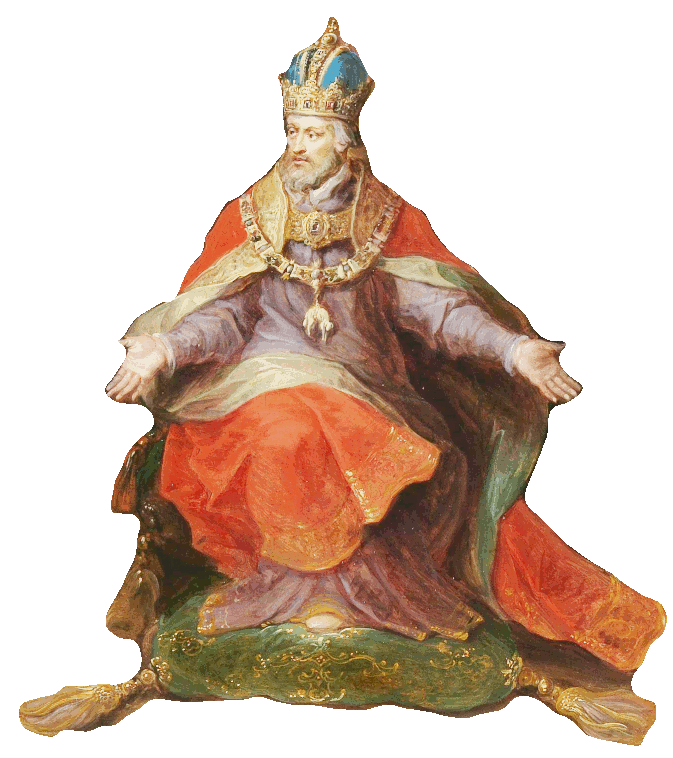
Flemish |
-
Charles V was born in 1500 as Charles Habsburg, in the Prinsenhof of Ghent, a Flemish city of the Habsburg Netherlands, to Philip of Austria and Joanna of Trastámara.
-
Known as Charles of Austria, Charles of Burgundy, Karl von
Habsburg and Carlos de Hapsburg.
- His mother Joanna was a younger daughter of Ferdinand II
of Aragon and Isabella I of Castile.
-
With the death of his grandfather Maximilian I, Charles V
ascended to the throne at age 19 in 1519.
|
The spelling "Habsburg" is the correct and most common
way to refer to the royal dynasty. The spelling
"Hapsburg" is an alternate, less common spelling often
found in older English publications. Both spellings
refer to the same European dynasty, a major ruling
family in Europe from the 15th to 20th centuries.
(Assistant)
|
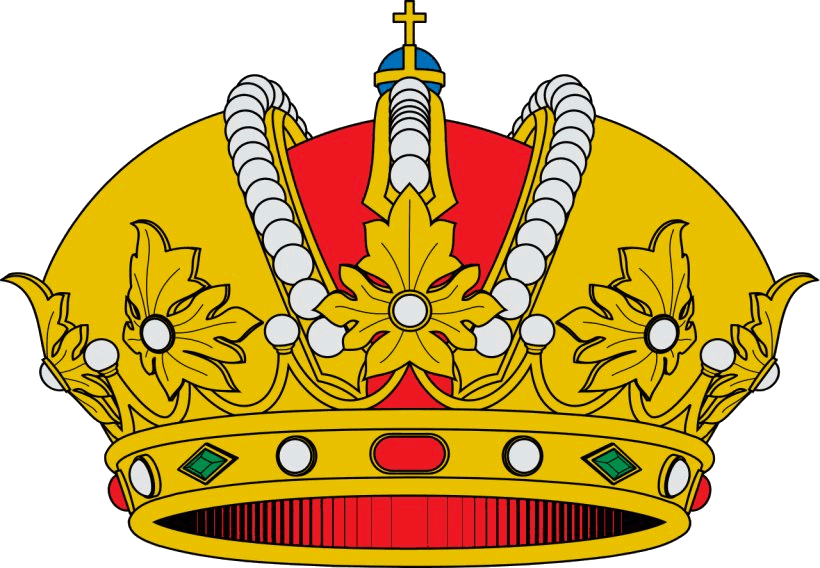
Editorial use
favpng by
odw3ikbd26infw4
Crown Coat Of Arms Of Charles V,
Holy Roman Emperor Heraldry |
- Charles V and Charlemagne were not related by blood, but Charles V consciously styled himself as a successor to Charlemagne.
- His reign and extensive territories spanned across Europe, and he
took the name of Charlemagne to emphasize the continuity of
the empire which included Spain, the Holy Roman Empire, and various Italian and Dutch territories.
|
Symbolic Relationship:
Charles V consciously associated himself with Charlemagne, aiming to create a sense of
imperial continuity, power and legitimacy for his own rule. He styled himself as a new Charlemagne, emphasizing the universal nature of his empire.
(Assistant)
|
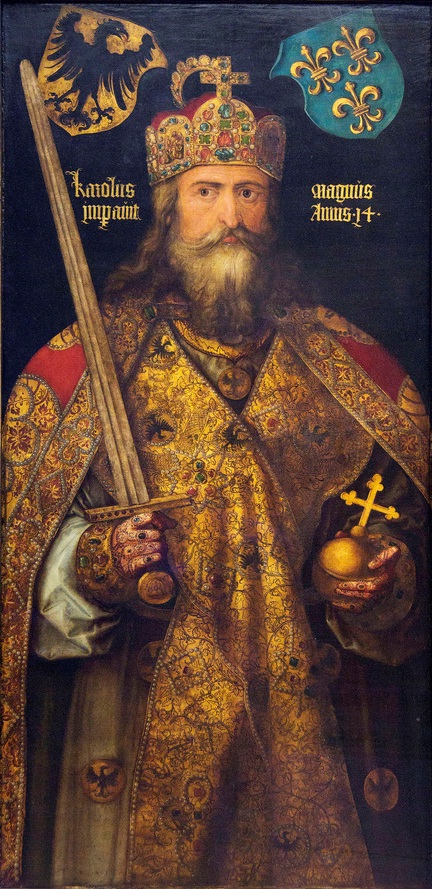
Albrecht Dürer, Public domain, via Wikimedia Commons
Charlemagne in regalia from the empire |
- He adopted the name 'Charles V' and wore the crown of Charlemagne in Aachen, Germany, during his coronation as Holy Roman Emperor.
- He also used the imperial regalia of Charlemagne and swore his oath on it.
|
There were many European kings named Charles II and Charles V. Charles II of France and the Holy Roman Empire (823-877) was the grandson of Charlemagne. None of the various kings named Charles V were closely related to Charlemagne.
(homework.study.com)
|
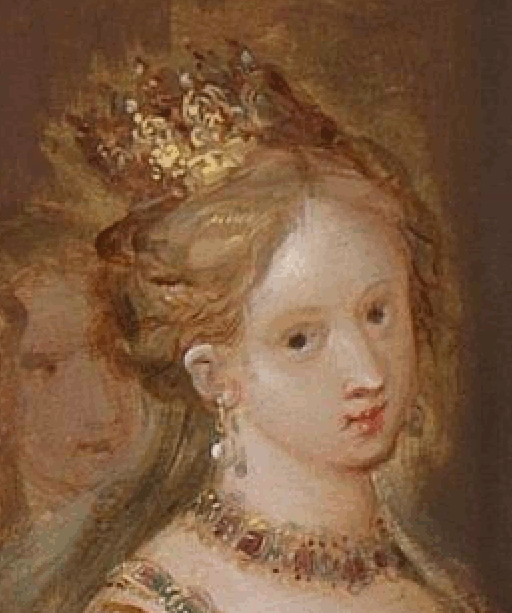
Isabella I of Castille |
-
Charles V's grandparents on his maternal side were Ferdinand
(1452-1516) of Aragon and Isabella I (1451-1504) of Castille whose marriage united Spain.
- On his paternal side his grandparents were Maximilian I
(1459-1519)
who was the previous Holy Roman Emperor, and Mary of Burgundy
(1457-1482).
- This lineage gave him claims as an heir to both the Austrian Habsburg and French Valois dynasties
which was Mary Magdalene and Christ's lineage.
|
Isabella I unified Spain through her marriage to Ferdinand II of Aragon, and she financed the expedition of Christopher Columbus, leading to the discovery of the Americas. She also completed the Reconquista but infamously expelled Jews and Muslims and empowered the Spanish Inquisition.
(Assistant)
|
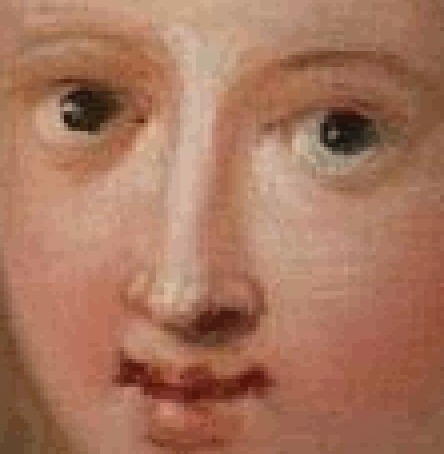
Joanna |
- From his mother Joanna's side of the family, Charles V
laid claim to Spain, parts of Italy, including Naples and
Sicily, and what became known as the Americas.
- From his
father, Philip the Fair, he was able to lay claim to the
German lands of the Holy Roman Empire through Maximilian,
his paternal grandfather.
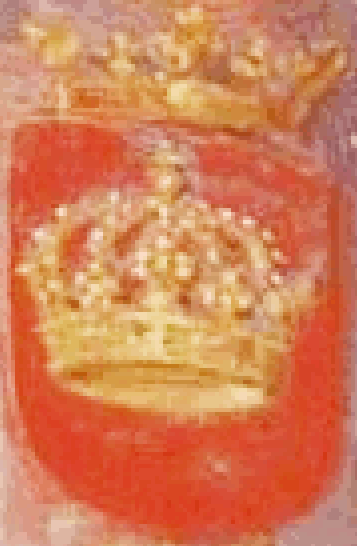
Regalia |
- At only 6-years old, Charles’ father, Philip of Castile, died and he inherited the Duchy of Burgundy and the sovereign nation known as The Habsburg Netherlands.
-
In 1516, King Ferdinand II of Aragon died and the 16-year old Charles of Burgundy was permitted to claim the thrones of Castile and Aragon.
- This was because his mother,
Joanna, the rightful queen, was mentally unstable and put in solitary confinement for her own
'safety.'
- Charles was now King of Spain and Duke of Burgundy.
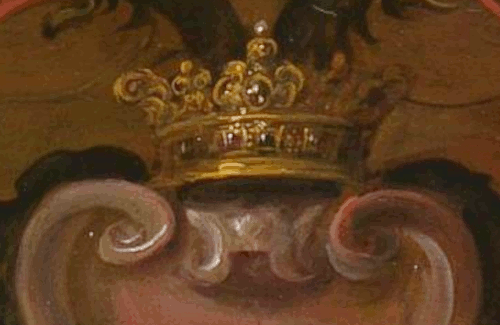
Promoted |
- In 1519, the Holy Roman Emperor Maximilian I died and an imperial election took place to confirm a male royal as the next Holy Roman Emperor.
- The choices were Charles I, King of Spain, who was the
paternal grandson of Maximilian I, Holy Roman Emperor.
-
Also Francis I, King of France,who was the nephew-in-law of Margaret of Austria, Emperor Maximilian’s daughter.
- Additionally, Henry VIII, King of England, whose first wife, Catherine of Aragon, was Charles of Spain’s maternal aunt.
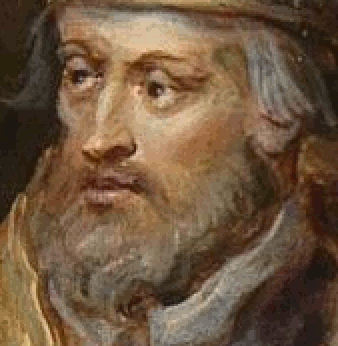
King Charles V |
- As a result of bribery and nepotism, Charles of Spain was confirmed as Holy Roman Emperor
and took the name Charles V.
- So this one man, Charles von Habsburg,
was the King of Spain, Holy Roman Emperor, Archduke of Austria, Duke of Burgundy and Lord of The Netherlands all in his own right.
- He was the most powerful king in Europe and not even the kings of France or England could challenge him.
|
Charles turned his attention to finding a bride and also took the time to arrange suitable marriages for his siblings and in the future, his children, nephews and nieces. Charles’ older sister, Archduchess Eleanor, was crowned Queen of Portugal once she married King Manuel I and was then crowned Queen of France when she became the second wife of King Francis I.
(Diarmuid)
|
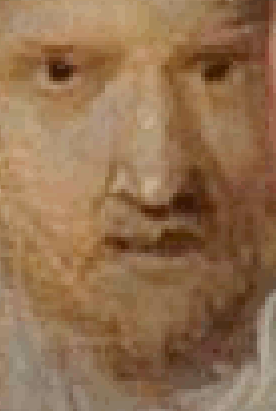
In debt |
- As always, money wins elections, and Charles V bid for
leader of the Holy Roman Empire was no exception.
- The
bribes he paid were so excessive he began his 16th-century
reign in debt, which is never a great idea.
- Unlike most
monarchs who rule countries, he not able to raise taxes to pay
his debt because that's not how the Holy Roman Empire works.
|
King Francis 1st of France was also a candidate for that high position and he bankrupted his mother and his reign to buy their votes. Charles out-promised him using the unlimited credit he received from that period’s leading bank…the electors accepted Francis’ money and then collected on Charles promissory notes.
(Tsuk János)
|
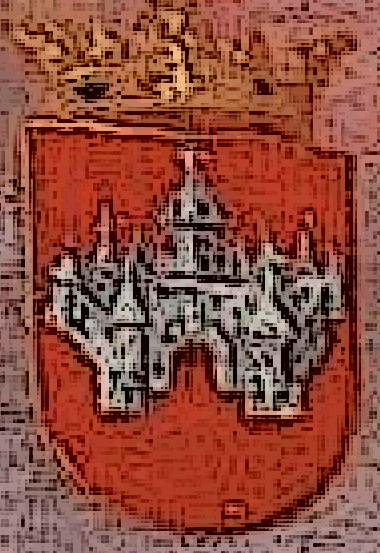
Heraldry |
- Truthfully though, no one was ever elected to this position
unless they already had a kingdom and a title and
coat-of-arms, so it seems like it was a sure thing,
especially with a grandfather who was a former Holy Roman
Emperor.
- You might say his existence was pretty
much a genetic engineering creation designed to produce a
ruler of Spain and Germany, only Charles V was neither
Spanish or German.
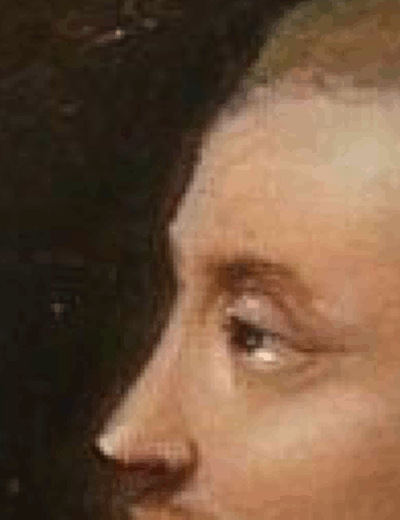
King Francis I |
- Charles V grew up in Belgium, in the
dukedom of Burgandy, which technically made him a French
subject, and with an ongoing feud with King Francis I of
France, it was an unpleasant position because of their
bitter rivalry.
- Charles knew that Francis I had
attempted to win the title of Holy Roman Emperor.
-
Francis I had warned the Electors that Charles was an unfit
and despotic man.
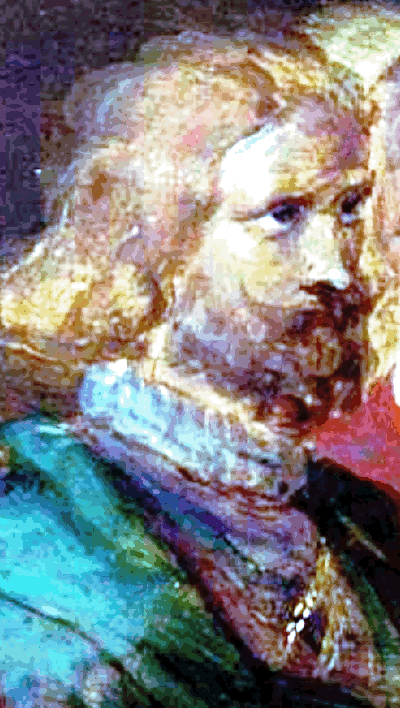
Charles V at war |
- The two monarchs ended up fighting four separate wars
against each other .
- Because Francis I had the ability to
tax his subjects in France and a religious class loyal to
him, as well as a population who all spoke the same
language, he should have won.
- Except Charles V's troops
won every war and they also managed to take Francis I
hostage at the siege of Pavia.
|
In 1525, King Francis I of France laid siege to Pavia, then under the control of Imperial troops, as part of the Italian War. The siege, however, was not successful, and the decisive Battle of Pavia resulted in a crushing defeat for the French and the capture of King Francis I by Emperor Charles V.
(Assistant)
|
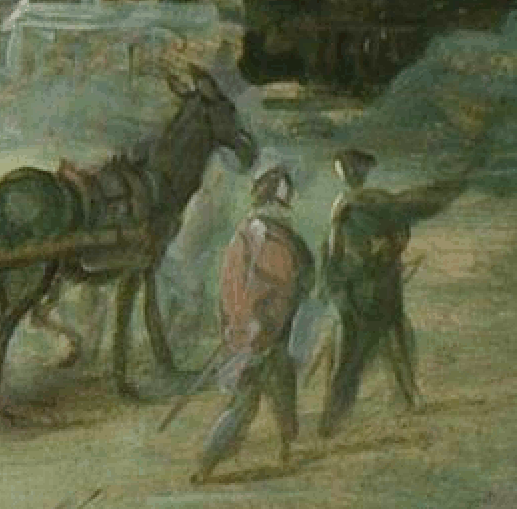
German militias |
- Germanic Barbarian tribes had invaded the empire in
1515 and were living in rural areas and were problematic.
- By
1521, they had moved into cities and towns and German
merchants had come to feel they had the right to speak in
Parliament and to have their say in taxes.
- They even
wanted to form their own militias.
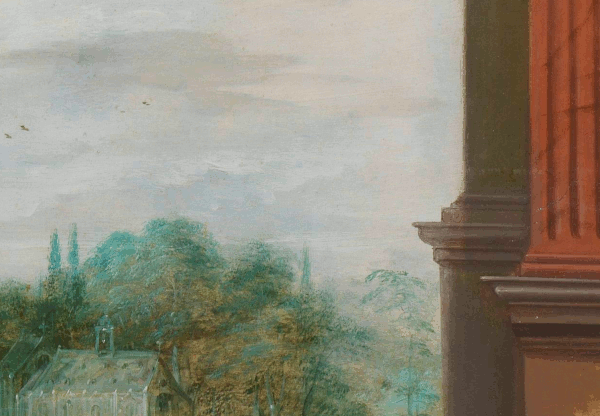
Rome |
- Charles V sacked Rome in 1527 which ended the Pope's hope
of becoming a real player in secular politics.
- Many
believe this ended the Italian Renaissance.
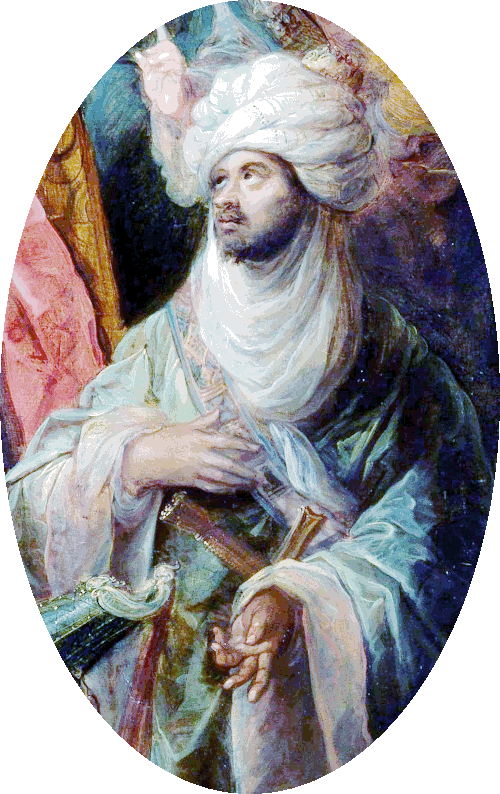
Suleiman the Ottoman |
- Charles V also fought a war against Suleiman and the
Ottomans and defeated tham at Vienna.
- However, he was not able
to stop Suleiman from consolidating his control over the
former Habsburg territory of Hungary.
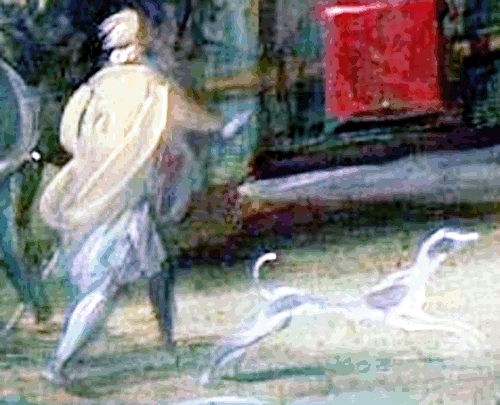
War dog |
- His reign was dominated by war beginning with the Habsburg-Valois conflict
where his forces were pitted against the French.
- The primary rivalry was between the Habsburg Emperor Charles V and the Valois King of France, Francis I.
- The conflict, also known as the Italian Wars, lasted
for approximately six decades between 1494 and 1559.
|
The Habsburg-Valois conflict is seen as a turning point in the evolution from medieval to modern warfare, with significant advancements in artillery and military organization. The wars were largely fought in Italy, with both sides vying for control of the peninsula.
(Assistant)
|
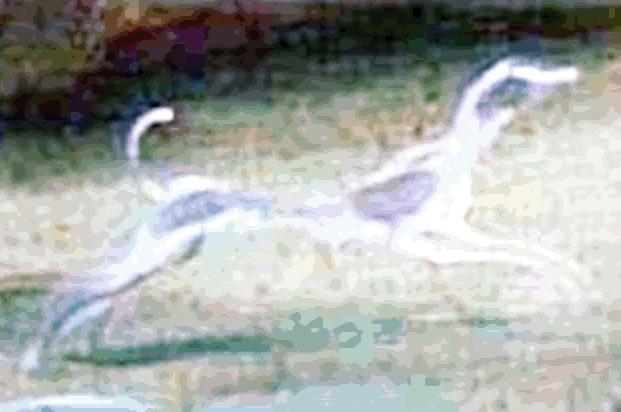
White dog |
- Fighting occurred in various locations
during 7 separate confrontations, over periods
intermingled with peace.
- Some of the monarchs involved
were Charles III of France, Louis XII of France, Pope Julius
II, Francis I of France and Henry II of France.
- Generally, a white dog is looking out for you and a black dog is an indication of danger.
- In places like Māori (near New Zealand), white dog hair was tied to weapons
as distractions.
In the context of whiskey, "white dog" refers to
unaged, or young whiskey, bottled straight from the
still, lacking the color and flavor imparted by barrel
aging, and is also sometimes called "white lightning"
or "white whiskey". (Assistant)
|
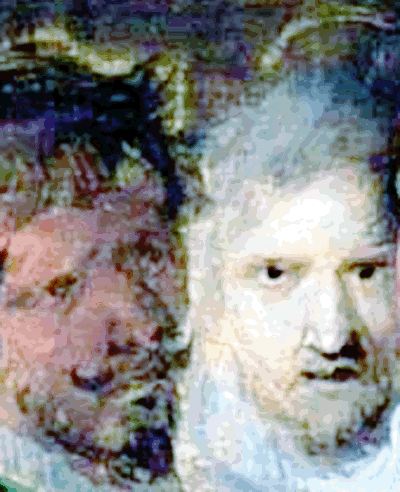
Religious struggles |
-
The wars occurred against a backdrop of the Reformation, which added religious tensions to the political rivalry between the Habsburgs and the Valois.
- Henry VIII of England also invaded France in the 1540s.
- Charles V also held off Turkish advances in Hungary and modern day Romania and clashed with various German
princes in the religious struggles of the 16th-century.
|
The conflict concluded with the Treaty of Cateau-Cambrésis in 1559, which resulted in Spanish Habsburg dominance in Italy and a shift of power to northwestern Europe.
(Assistant)
|
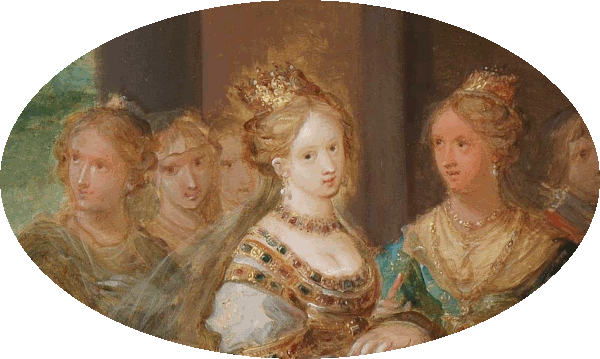
Some of Henry VIIIs multiple wives |
- In 1508 Charles V had been nominated by Henry VII to the
Order of the Garter and his Garter stall plate survives in Saint George's Chapel.
- Much of Charles's reign was taken up by conflicts with France, which found itself encircled by Charles's empire while it still maintained ambitions in Italy.
- In 1520, Charles visited England, where his aunt, Catherine of Aragon, urged her husband, Henry VIII, to ally himself with the Emperor.
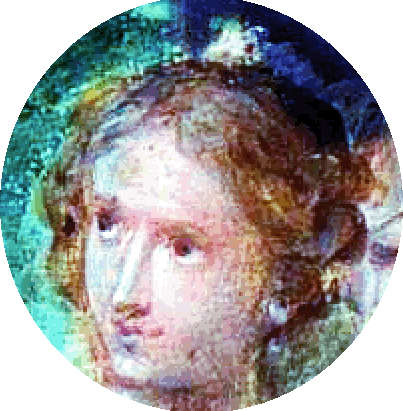
Catherine of Aragon, Queen of England |
-
Charles V's beloved aunt, Catherine of Aragon, was threatened with deposition and banishment after she refused to accept
an annullment.
- Her husband, Henry VIII of England wanted to
displace Catherine and marry Anne Boleyn in order to procure a legitimate son.
- Catherine of Aragon was stripped of her title as 'Queen of England' and Charles’ cousin, Mary Tudor, was stripped of her title as
'Princess' and now only referred to as 'The Lady Mary Tudor.'
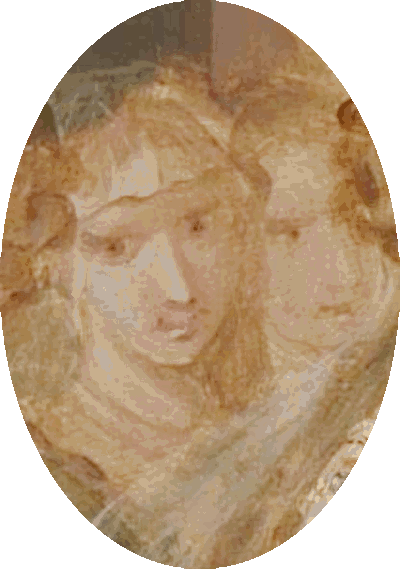
Ladies in waiting |
- Charles V threatened to declare war on England for the insult that Henry had delivered to his aunt and cousin but never actually made good on his threat.
- However, he did successfully convince Pope Paul III to excommunicate King Henry VIII in order to denounce him as a heretic.
- This permitted his Catholic congregations in foreign nations to depose the King of England if necessary.
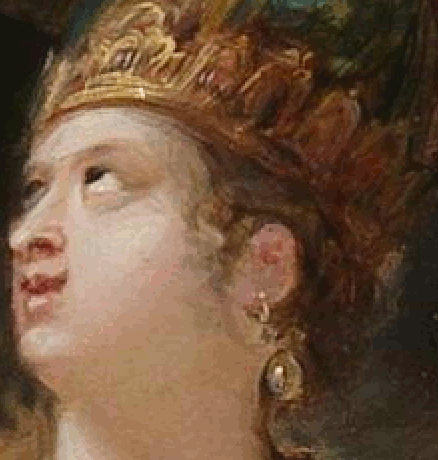
Christina of Denmark eyeroll |
- After Henry VIII of England got rid of Catherine of
Aragon, he sought the hand of Charles’ maternal niece, Christina of Denmark, Dowager Duchess of Milan, in marriage.
- She refused to become Henry’s queen as she knew exactly what had happened to his first three wives who had all ended up dead.
- The first, Catherine of Aragon, Charles V’s aunt, was
banished in disgrace and confined to a damp and draughty
room where she died a slow and painful death.
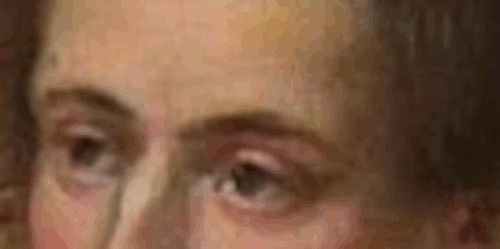
Martin Luther |
-
It was Charles V as Holy Roman Emperor, who took the lead as the champion of Catholic Orthodoxy.
- He called Martin Luther
(1483-1546) in 1521 to appear before the Diet of Worms
and he would later outlaw him.
- The Diet was a meeting of the most significant political authorities in the Holy Roman Empire.
- However, Luther was so compelling after the Diet of
Worms he became more popular.
- Shortly after, he began
his famous German translation of the Bible.
|
The Diet of Worms was a meeting of the Holy Roman Empire held in 1521, most famously known for Martin Luther's appearance before it to respond to charges of heresy. During the Diet, Luther refused to recant his views, leading to his excommunication and being declared an outlaw.
(Assistant)
|
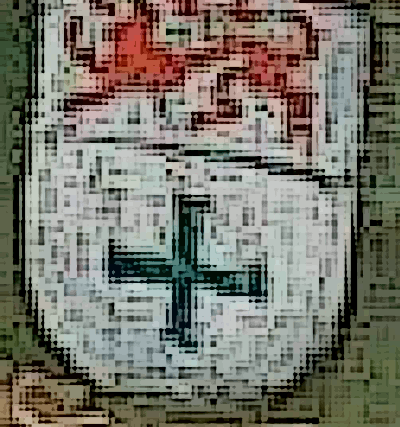
Pope Leo X |
-
Luther's Ninety-Five Theses, published in 1517, challenged the authority of the Catholic Church, particularly regarding the selling of indulgences
(for removal of sin at a cost).
- He refused the beliefs
of traditional authorities, as well as those paintings and
sculptures that he felt polluted the churches because they
were false icons.
- The Diet's purpose was
to address the challenges posed by Martin Luther's teachings
and his defiance of the church.
- Luther continued to write and preach against the
church, leading to his excommunication by Pope Leo X in 1521.
|
As emperor he needed to deal with the fast growing new religion that a certain Luther had proclaimed and which the Church thoroughly condemned. Catholicism used to function in a simple hierarchical manner : the
Pope, the cardinals, the bishops and the priests all communicated in Latin and the faithful gullible people believed that the Bible said what those educated authorities told that it did. Also the people gave much of their wealth to the Church in order to buy their escape from Purgatory. (Tsuk János)
|
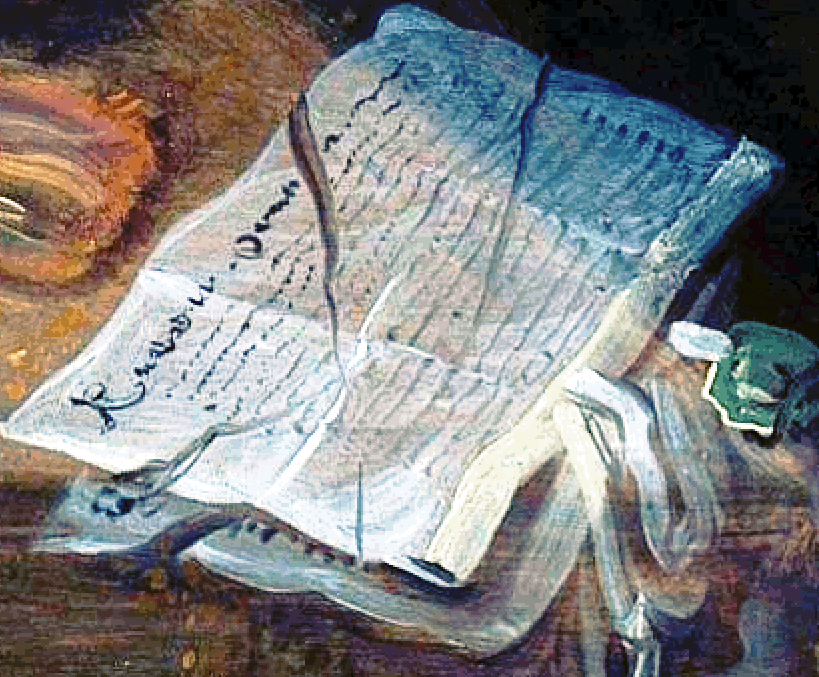
Augsburg Treaty in 1555 |
-
For over 25 years Charles V fought an unwinnable war; he wanted
not only to maintain the unity of the Empire, but to keep it faithful to the Catholic religion.
- In 1555 a compromise was reached called the Augsburg Treaty
which specified that the inhabitants of the various German principalities
were to follow the religion of their princes, not the Holy
Roman Empire.
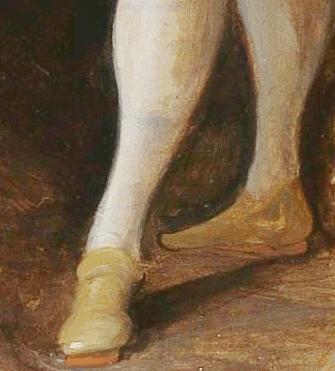
Always in a rush |
- At the same time, Charles V needed to face the Muslim pirates who
were based in Tunis and kept the Mediterranean unsafe,
-
He had a hard time concentrating his resources on any single battle field and
ultimately, spent his life rushing from one war to the other.
|
Having been born a king he believed that his position
was directly due to God and it involved the obligation
to protect the Church against all non believers and to
fight both Protestants and Muslims. He faithfully
obeyed this calling.
(Tsuk János)
|

Council of Trent |
- Charles
V headed up the Council of Trent that caused the Counter Reformation
where he took a strong stance against the Lutheran Schmalkaldic League.
-
This was the 19th ecumenical council of the Roman Catholic Church
and was a pivotal event that was held between 1545 and 1563 in Trent, Italy.
- It was convened in response to the Protestant Reformation, primarily to define Catholic doctrine and address abuses within the
church.
|
The Schmalkaldic League was a military alliance of Lutheran principalities and cities within the Holy Roman Empire during the mid-16th century. It received its name from the town of Schmalkalden, where the group was founded in 1531.
(Wikipedia)
|
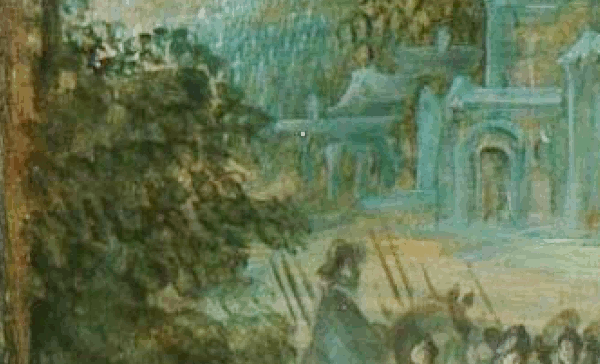
Battle of Mühlberg |
- Charles V's forces were victorious against those of the Protestants at the Battle of Mühlberg but were beaten back in the Netherlands.
|
The Battle of Mühlberg took place near Mühlberg in the Electorate of Saxony in 1547, during the Schmalkaldic War. The Catholic princes of the Holy Roman Empire led by the Holy Roman Emperor Charles V decisively defeated the Lutheran Schmalkaldic League of Protestant princes. (Wikipedia)
|
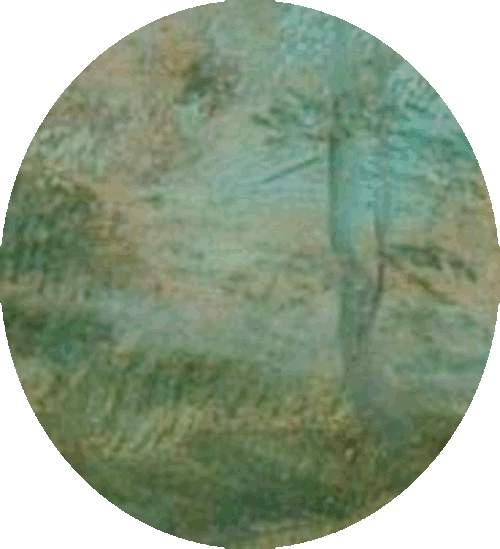
New World |
- Charles V ruled one of the largest empires in
history, behind Genghis Khan and Stalin in the Soviet Union.
- In addition to ruling most of Europe, during his
lifetime, one of his dominions, Spain, laid claim to nearly
all the New World outside of Brazil.
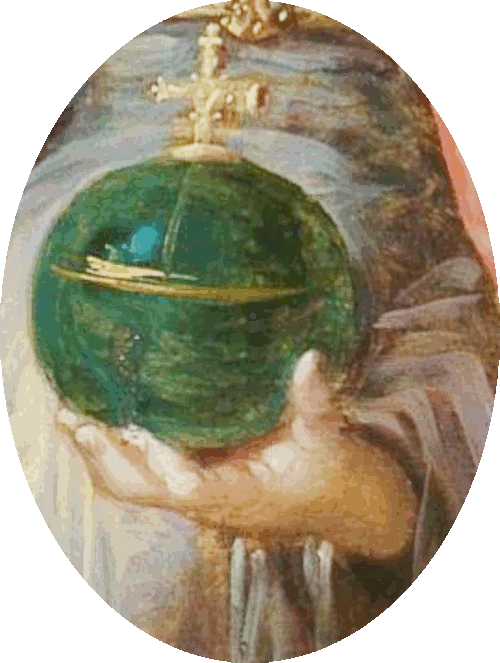
Empire regalia
|
- The survivors of the fleet of explorer Ferdinand
Magellan were the first humans to circumnavigate the globe.
- You might say that Charles V created the 'template' that was
used for colonization of the Americas and the Christianization
of indigenous people.
- He also gave his seal of approval
to the Catholic Jesuit Order to convert Asia to Catholicism.
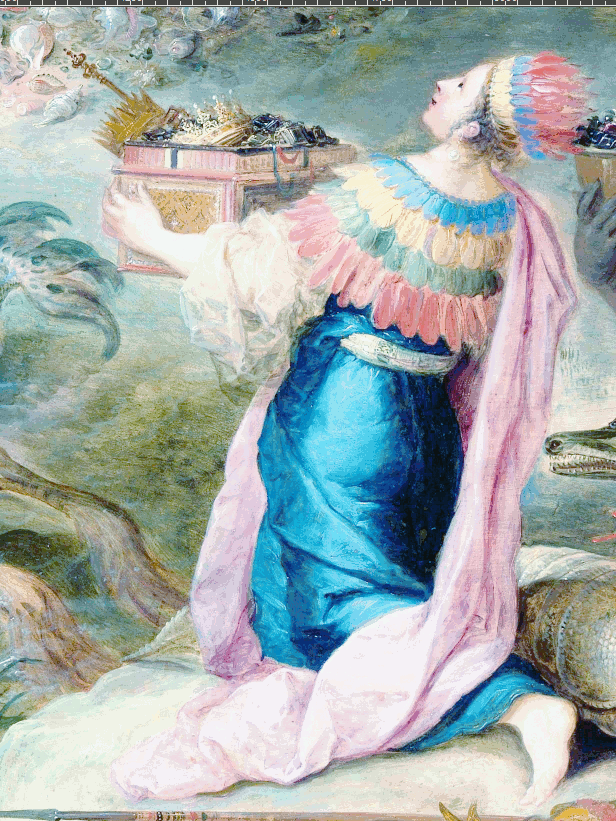
Island queen |
- Charles V oversaw the first mission settlements in
California and began the process of turning the islands known
as the Philippines, which were part of Asia, into a
Spanish-speaking country.
- He hosted the Valladolid
debates which were the first-known discussions of universal
human rights and he sought to end slavery for many.
-
Although he never ended slavery for anyone.
|
The Valladolid debate was a significant moral and theological discussion held in 1550-1551 in Spain. It focused on the rights and treatment of indigenous peoples in the Americas by European colonists, particularly the Spanish. The debate was convened by King Charles V to address questions about the justifiability of Spanish conquest, their treatment of indigenous populations, and the methods used to convert them to Catholicism.
(Wikipedia)
|

Slave master |
- The main reason Charles V's attempts to end slavery didn't
work was because the Spanish conquistadors in the New World
ignored his orders and kept handing out encomiendas.
- This is a grant by the Spanish Crown to a colonist in America conferring the right to demand tribute and forced labor from the Indian inhabitants of an area.
|
When the Spaniards conquered the New World, they resorted to a form of native labor organization called the encomienda. The encomienda differed from slavery in that the Crown imposed inheritance, trading, and relocation restrictions on encomenderos.
(Assistant)
|
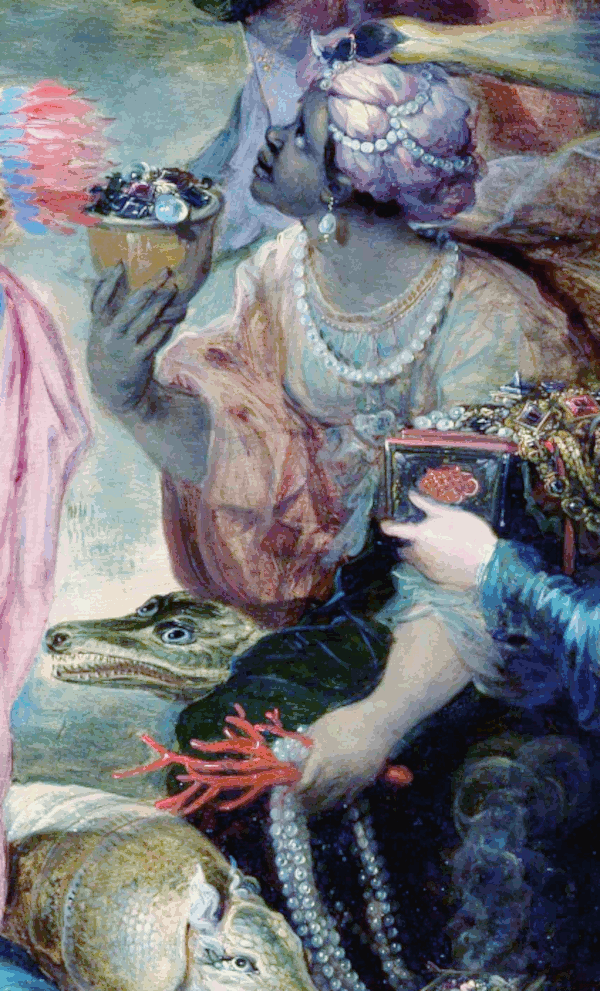
Native in the Americas |
- An enraged Charles sent more instructions that no Indians
could be enslaved by Christians and they should be freed.
- Hernán Cortés (1485
-1547) was a Spanish conquistador who overthrew the Aztec empire
in 1519–21 and won Mexico for the crown of Spain.
- Cortés responded and told him the majority of
conquistadors were of low quality, violent and vicious, and
impossible to control so Charles V caved and allowed them to
issue temporary encomiendas.

27 wars |
- It is often implied that Charles V and the Habsburgs gained their vast empire through peaceful policies,
his grandfather, Maximilian I had carried a very financially
risky policy of maximum expansionism.
- For example, Maximilian and his descendants fought wars aplenty
and he alone fought 27 wars during his four decades on the
throne.
|
Let others wage war, but thou, O happy Austria, marry; for those kingdoms which Mars gives to others, Venus gives to thee.
((Mathias Corvinus)
|
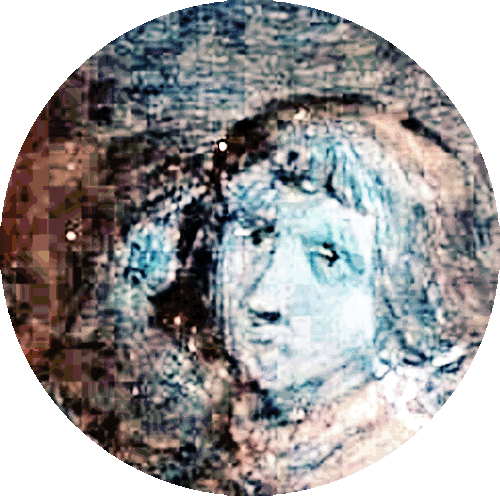
Rebellious subjects |
- Of course it's hard to rule an empire filled with
rebellious subjects such as Martin Luther and with territory
in two hemispheres.
- Charles V managed to bankrupt the
kingdom during his reign.
- This was significant because he
had access to all the silver and gold in the New World as well
as the Renaissanse banking fortunes of Italy and the
Netherlands, and the military strength of Spain.
|
In short, Charles V was to the Holy Roman Empire what
Screech is to the Saved by the Bell alumni..
(CrashCourse)
|
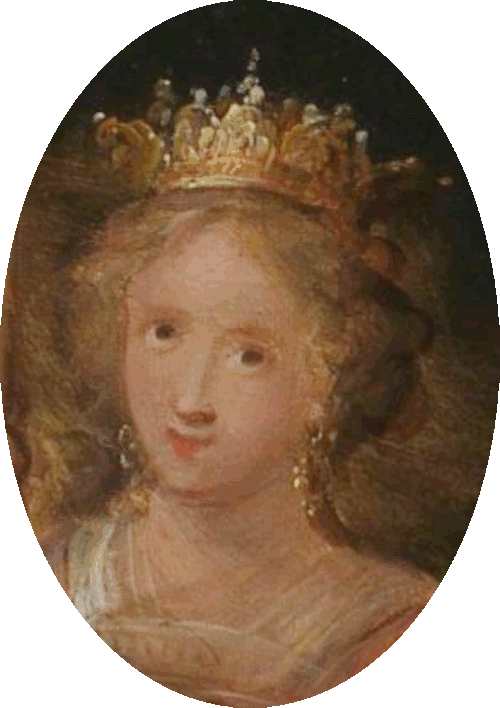
Margaret of Austria |
-
Charles V ordained members of his family to reign over parts of his empire in
his name so he really had delegated quite a bit of his
royal authority to others.
- The Habsburg Netherlands were first governed by Charles’ aunt, Margaret of Austria, then by his sister, Mary of Hungary, and finally by both of his illegitimate offspring, John of Austria and Margaret of Parma.
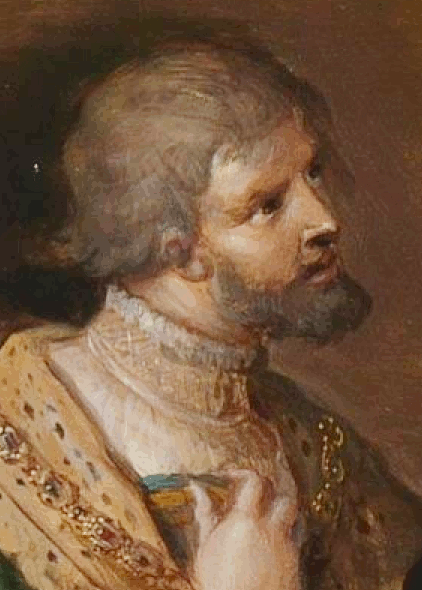
Younger brother
Ferdinand I |
- The Holy Roman Empire itself was governed by Charles’ younger brother, Ferdinand I, King of The Romans and King of Bohemia and Hungary.
- Spain was mostly governed by Charles V himself, but when he went abroad, he would designate his wife, Empress Isabella, as queen-regent.

Governing wide areas |
- It's easy to see why
Charles V needed so much help from his
relatives because governing all of Europe and the Americas
except Brazil, especially with communication so difficult,
was a tremendously difficult job, if not impossible.
-
With the Spanish conquistadors subjugation of the American
Indians by the late 1830s, Charles V's job was even harder
because he had so many more subjects and continuing problems.
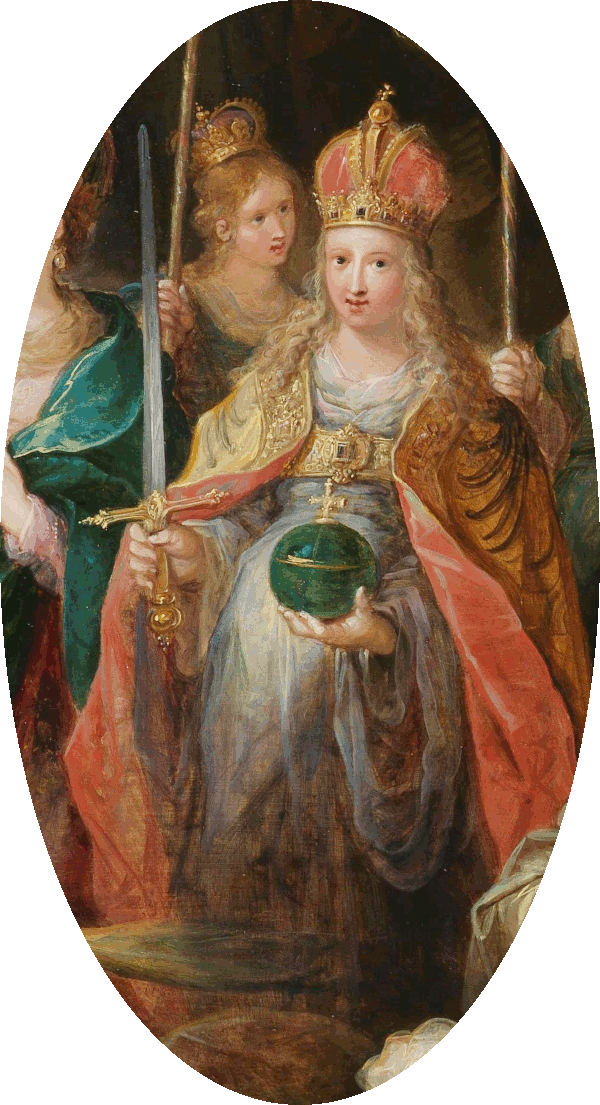
Isabella of Portugal |
- Disaster struck when
his wife, Isabella of Portugal died in 1539
as the couple had been very happy together.
- Charles V was distraught and found himself unable to leave her bedside.
- His grief as a widower threatened to destroy everything he had worked for as his vast empire was now without a ruler.
- His eldest son, Philip, Prince of Asturias, was only 14–years old but he had to step up and take charge.
|
Isabella of Portugal (1503-1539)
was the empress consort of Charles V, Holy Roman
Emperor, King of Spain, Archduke of Austria, and Duke
of Burgundy. She was Queen of Spain and Germany, and
Lady of the Netherlands from 10 March 1526 until her
death in 1539, and became Holy Roman Empress and Queen
of Italy in February 1530. She acted as regent of
Spain during her husband's long absences.
(Wikipedia)
|
|
Habsburgs Split |
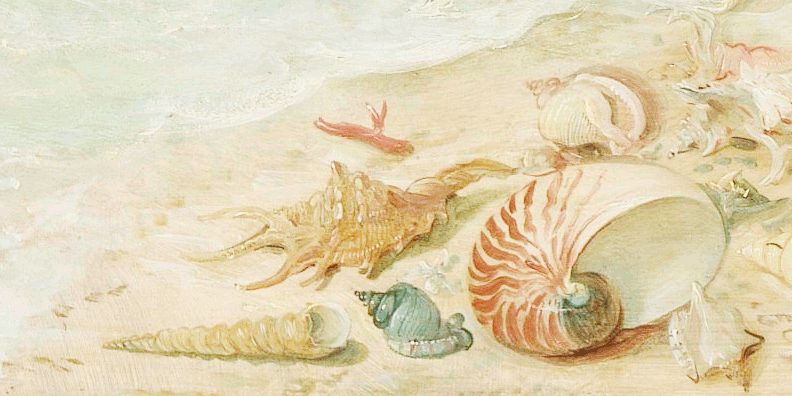
Large empire |
- It was in 1554-1556, at a point that the empire was
on the decline, Holy Roman Emperor Charles V, as he was known in
Europe, divided his lands.
- Charles Habsburg was also known as
Carlos I in Spain.
- He gradually divided the Habsburg empire and the House of Habsburg between a senior Spanish line and a German-Austrian branch.
- His abdications all occurred at the Palace of Coudenberg in Brussels.
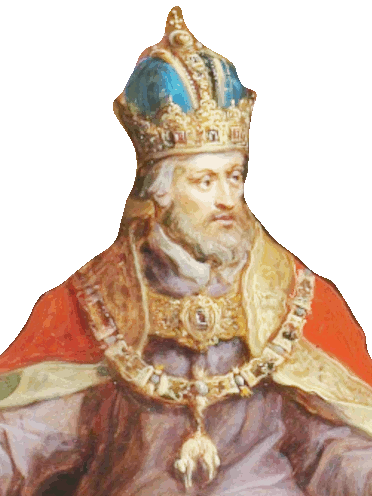
Is it a church or a throne? |
- The empire was, during Voltaire's time, not unified by religion.
- Traditionally, the Holy Roman Emperor had been the chief Christian monarch,
however, it was no longer solely Catholic.
- It was supposed to be the temporal arm of the
Pope's spiritual authority, a role that was gradually being usurped by the
kings of Spain and France.
|
The Holy Roman Empire was neither holy, nor Roman, nor an Empire. (Voltaire)
|
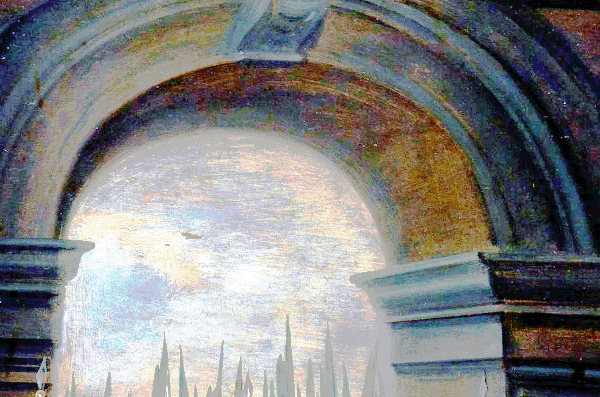
Monastery in Spain |
- Charles V abdicated in 1554 during the reign of Pope
Julius III and handed over control of Sicily and Naples to his son Philip who would become King of Spain in 1556.
- His brother Ferdinand I would take over as Archduke of Austria and Holy Roman Emperor.
- He spent the remainder of his life as a Monk at the Monastery of Yuste in Spain.
|
I must for my part confess that I have often misled myself, either from youthful inexperience, from the pride of mature years, or from some other weakness of human nature. I nonetheless declare to you that I never knowingly or willingly acted unjustly ... If actions of this kind are nevertheless justly laid to my account, I formally assure you now that I did them unknowingly and against my own intention. I therefore beg those present today, whom I have offended in this respect, together with those who are absent, to forgive me. (Charles
V)
|
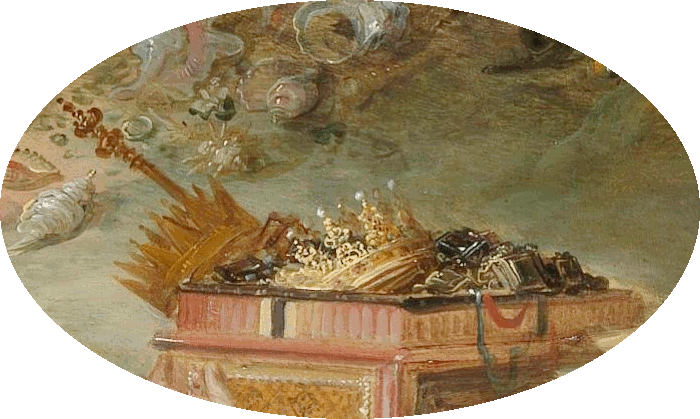
Failed state |
-
Charles V's abdication was a key event in his reign, marking the end of his vast empire and the beginning of separate Habsburg realms.
-
He was never considered a powerhouse in world
history.
- In fact, his realm, the Holy Roman Empire, was
ultimately a failed state and his reign a bitter
disappointment, even to himself.
|
He lived alone in a secluded monastery, surrounded by paintings by Titian and with clocks lining every wall, which some historians believe were symbols of his reign and his lack of time.
(Wikipedia)
|
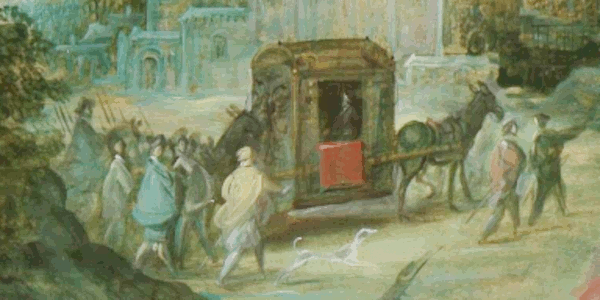
Charles departs |
-
By the time Charles V died at age 58 in 1558, he was crippled with gout and
malaria.
- The Holy Roman Empire was defaulting on
massive debts to its creditors.
- He tried to stamp out
th Protestant Reformation and push his Catholic
Counter-Reformation around the world.
- He was trying to
create new policies in the New World, while still defending
old policies in the Old World, Europe.
|
Following his return to Spain in 1559, their son Philip undertook the task of fulfilling his father's wish when he founded the Monastery of San Lorenzo de El Escorial. After the Monastery's Royal Crypt was completed in 1574, the bodies of Charles and Isabella were relocated and re-interred into a small vault directly underneath the altar of the Royal Chapel, in accordance with Charles's wishes to be buried "half-body under the altar and half-body under the priest's feet" side by side with Isabella.
(Wikipedia)
|
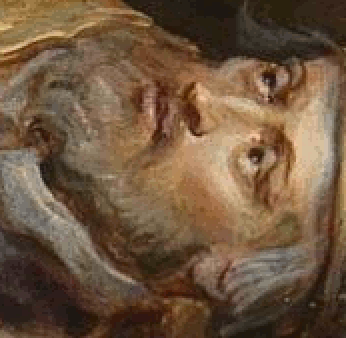
Charles V ceases |
- The empire had ceased
to be 'Holy' in the sense that it was no longer strictly
Catholic, and it was never Roman since Latin was not among
the many languages spoken there.
- It also wasn't much of
an empire because it was too diverse and spread too far for
Charles V to ever really have power as an emperor.
- Charles never traveled to his overseas possessions in the Americas, since such a transatlantic crossing at the time was unthinkable.
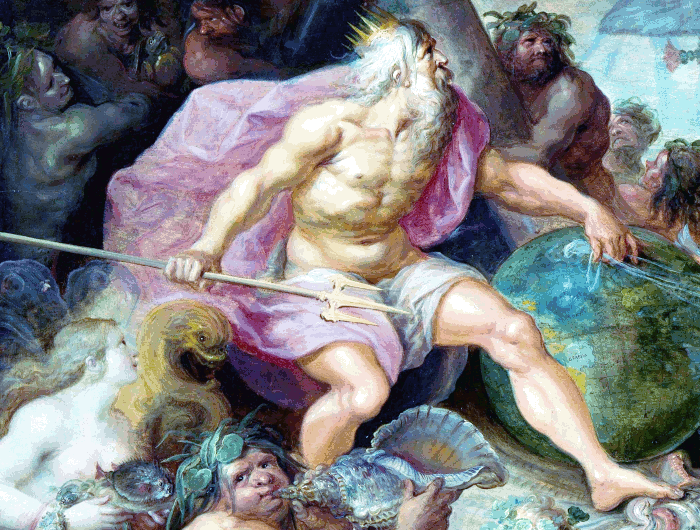
Division of the world
Japheth (Poseidon) went north to the Caucasians |
- The division of the world between Philip II of Spain and Emperor Ferdinand I occurred primarily through a process of abdication and inheritance, not a formal treaty.
- Charles V, the Holy Roman Emperor, abdicated his titles and lands, passing on the Spanish and Italian territories to Philip II, and the Austrian and German lands to his brother Ferdinand.
- This effectively divided the Habsburg territories, creating the foundation for separate Spanish and Austrian dynasties.
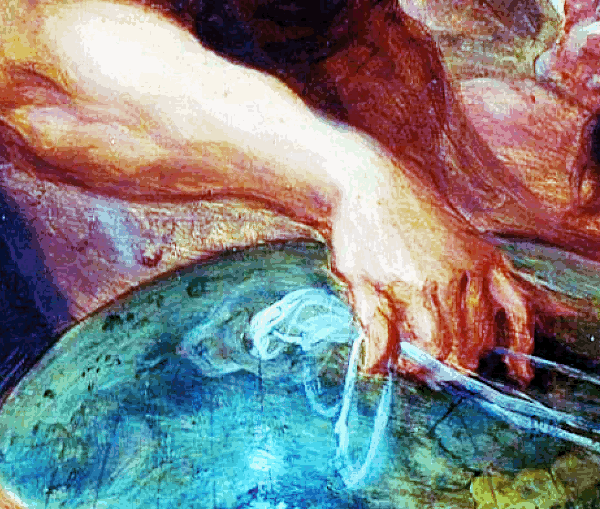
Tax collector |
- Over its 1,004 year history, the Holy Roman Empire never had the
means of levying direct taxes, or money to raise an army.
- A fact that significantly impacted its governance and ability to maintain control over its vast and diverse territories.
- Its finances and military were largely reliant on the contributions of its constituent states, making it difficult to form a unified and powerful entity.
- Then Jesus said to them, 'Give back to Caesar what is Caesar's and to God what is God's.' And they were amazed at him.
- Give the taxes to the real government, Caesar,
who will use it to build for the citizens, and you owe YHWH
whatever he is owed, and that is not taxes because his
empire did not establish taxes.
|
This is also why you pay taxes, for the authorities are God’s servants, who give their full time to governing. Give to everyone what you owe them: If you owe taxes, pay taxes; if revenue, then revenue; if respect, then respect; if honor, then honor.
(Romans 13:6-7)
|
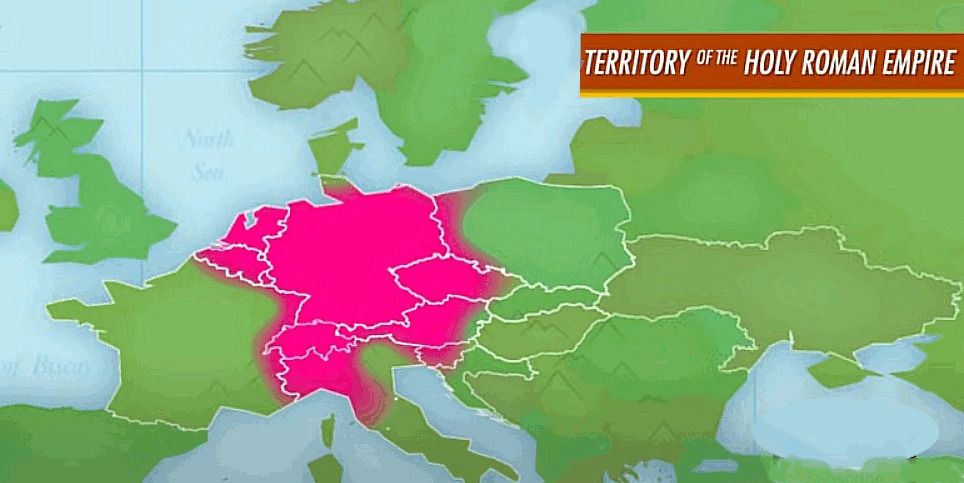
Map of the Empire and its growth over time |
- The Empire encompassed the area that today includes Eastern France,
Luxembourg, Germany, Austria, Italy and Czechoslovakia.
-
There were times it stretched to the Netherlands,
Belgium, Croatia, Poland, Hungary and western Ukraine.
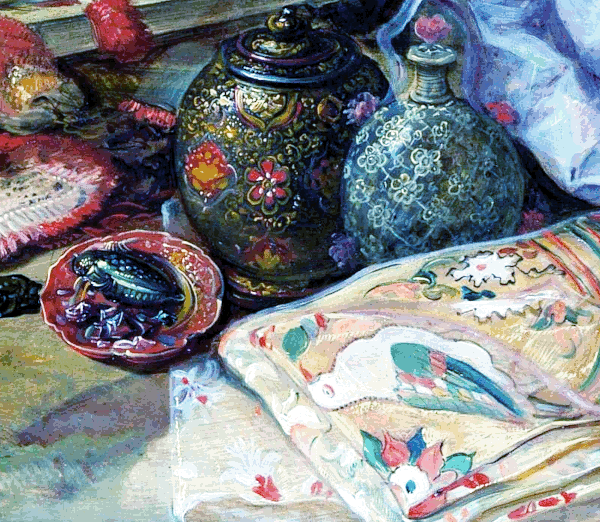
House of Habsburg |
- This division laid the groundwork for foundation of two
separate dynasties, the Spanish Habsburgs (led by Philip II) and the Austrian Habsburgs (led by Ferdinand I), two separate branches of the Habsburg dynasty.
- This had a significant impact on the political and
cultural landscapes of Europe, as Spain and Austria
developed along distinct paths.
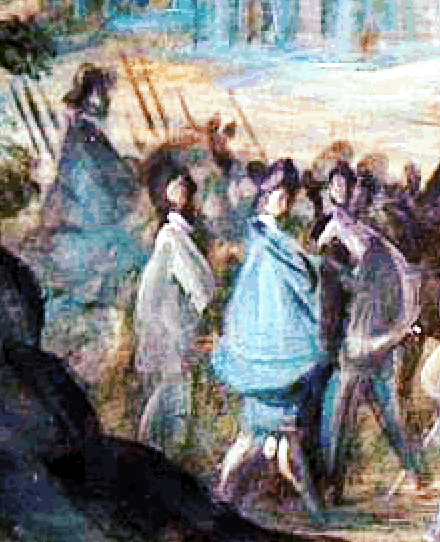
Lacked the nationalism |
- Some wonder if Charles V could have been a good emperor
because the empire itself, was doomed to fail largely
because it lacked the nationalism that powered rising
nation-states like France and England.
- But like
everything, there is always a good side and a bad side.
-
The last Holy Roman Emperor, Francis II, abdicated in 1806 during the Napoleonic Wars.
|
Ferdinand I |
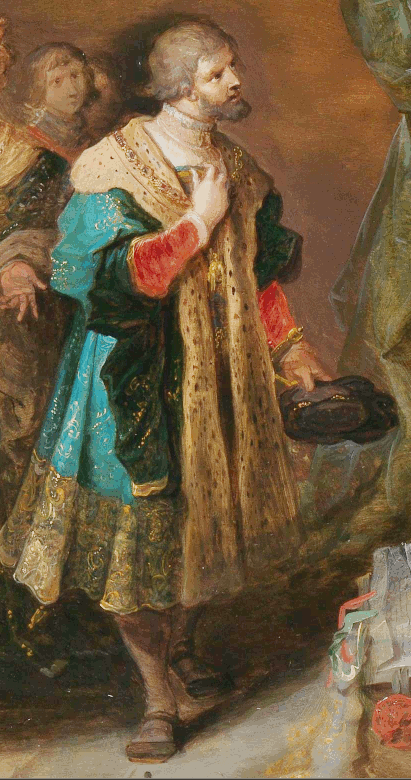
Holy Roman Emperor |
-
Ferdinand I (1503-1564), the second son of Philip I of Castile and Joanna of Castile, who was Charles V's brother, inherited the Holy Roman Empire.
- He was Holy Roman Emperor from 1556, King of Bohemia, Hungary, and Croatia from 1526, and Archduke of Austria from 1521 until his death in 1564.
-
He was also quite the accomplished musician.
|
Music played an important part in his childhood. When he was an infant, his maternal grandmother, Isabella I of Castile, ordered that among the 24 servants attending the newborn, there should be four musicians. In 1505, after Isabella's death, King Ferdinand established for the younger Ferdinand a household with 62 servants and his own music chapel.
(Wikipedia)
|
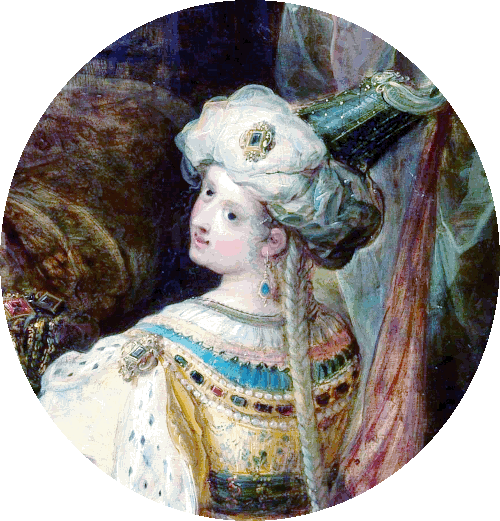
Anna of Bohemia |
- In 1521 in Linz, Austria, Ferdinand married Anna of Bohemia and Hungary (1503–1547), daughter of Vladislaus II of Bohemia and Hungary and his wife Anne of Foix-Candale.
- They had 15 children, all but two of whom reached adulthood:
|
IFerdinand was also a patron of the arts. He embellished Vienna and Prague. The University of Vienna was reorganized. He also called Jesuits to the capital city, attracted architects and scholars from Italy and the Low Countries to create an intellectual milieu surrounding the court.
(Wikipedia)
|
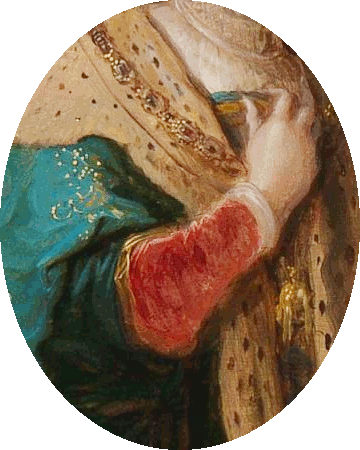
Legal and suo jure rule |
- Succession was formally recognized by the prince-electors
assembled at Frankfurt in 1558.
- The Pope refused to recognize Ferdinand as emperor until 1559, when peace was reached between France and the Habsburgs.
- The Imperial abdication also marked the
beginning of Ferdinand's legal and suo jure rule in the
Austrian possessions, that he governed in Charles's name
since 1521–1522.
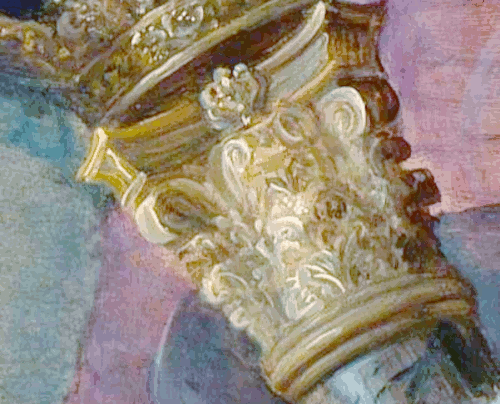
Imperial capital |
- Unlike Maximilian I and Charles V, Ferdinand I was not a nomadic ruler.
- In 1533, he moved his residence to Vienna and spent most of his time there.
- After experiencing the Turkish siege of 1529,
Ferdinand I worked hard to make Vienna an impregnable fortress
and after his 1558 accession, Vienna became the imperial capital.
- He was able to introduce more uniform governments for his realms and also strengthen his control over finance in Bohemia, which provided him with half of his revenue.
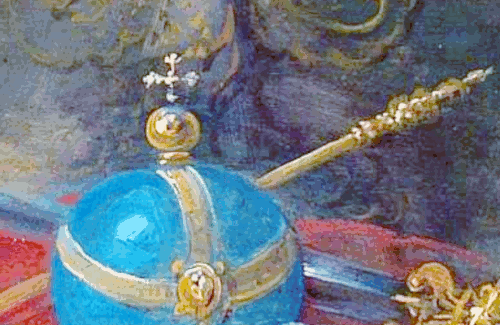
Catholic response |
- Ferdinand I was a supporter of the Counter-Reformation and helped lead the Catholic response against what he saw as the heretical tide of Protestantism.
- For example, in 1551 he invited the Jesuits to Vienna and in 1556 to Prague.
- Finally, in 1561 Ferdinand revived the Archdiocese of Prague, which had been previously
shuttered due to the success of the Protestants.
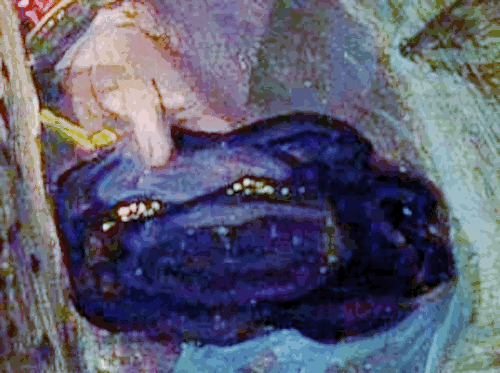
Collection hats out |
- A rudimentary union between Austria, Hungary and Bohemia was formed though, on the basis of common legal status.
- Ferdinand I had an interest in keeping Bohemia separate from imperial jurisdiction and making the connection between Bohemia and the empire looser.
- This is because Bohemia did not have to pay taxes to the empire
and he did not want to pay their expenses, so he kept them
at a distance.
|
In Hungary, the monarchy remained elective until 1627 (with Habsburgs' female inheritance rights being acknowledged in 1723), although the kings that followed Ferdinand would always be Habsburgs.
(Wikipedia)
|
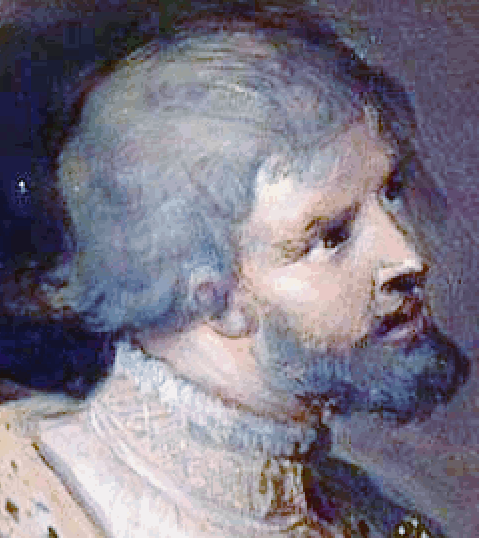
Ferdinand an eye for an eye |
- Although not a military leader, Ferdinand was a capable organizer with institutional imagination.
- He was focused on building a centralized government for Austria, Hungary, and Bohemia instead of striving for universal monarchy
like Philip II.
- Ferdinand was considered a mediocre military commander but an energetic and very imaginative administrator, who produced a framework for his empire that endured into the
18th-century.
- He died in Vienna in 1564 and is buried in St. Vitus Cathedral in Prague.
- After his death, Maximilian, his eldest son, ascended
the throne unchallenged.
|
Let justice be done, though the world perish.
(Ferdinand I)
|
|
Philip II |
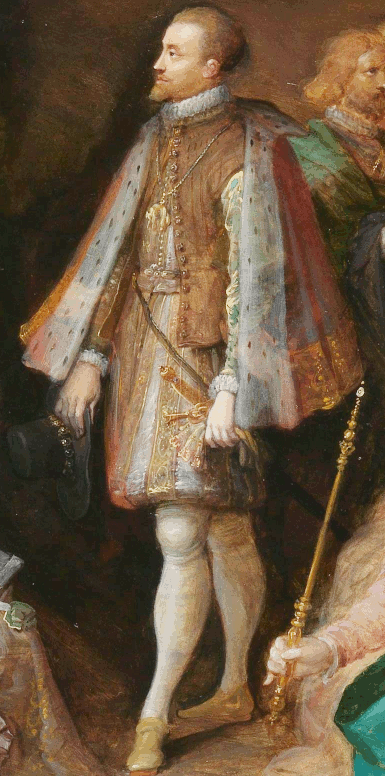
The Prudent |
- The son of Emperor Charles V and Isabella of Portugal, Philip
II of Spain (1527-1596) inherited his father's Spanish Empire in 1556, and succeeded to the Portuguese throne in 1580.
- He was also Lord of the Netherlands, essentially gaining control over the Spanish and Dutch territories.
- He was a patron of the arts, a refined collector, and a
builder and visionary.
-
Suffucating and thought of by his subjects as boring and
arrogant.
|
The Spanish conquests of the Inca Empire and of the Philippines, named in his honor by Ruy López de Villalobos, were completed during his reign.
(Wikipedia)
|
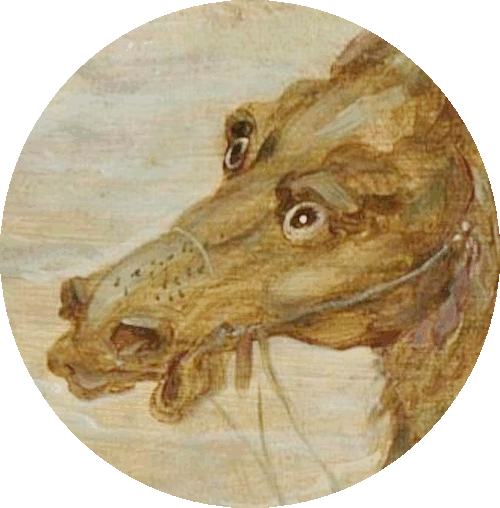
Government matters on horse |
-
After extensive travels both during Charles V reign and initially his own, Philip returned to Spain, where he liked the country, the language and the climate and built the Escorial, a huge royal palace/convent near Madrid.
-
From his desk he read volumes of reports and dispatched endless instructions
and since he was the leading power of Europe, he was permanently engaged on multiple fronts.
- Governing such a vast area was almost impossible,
especially when all national matters were handled on
horseback.
- By the time the
empire was dismantled it had fairly little power over its member states.
|
Philip would become the consummate bureaucrat during his reign, overseeing a great deal of minutiae and a mountain of paperwork on a daily basis. The Spanish Empire around the world was governed along the same guidelines as the Castilian monarchy.
(Susan Abernethy)
|
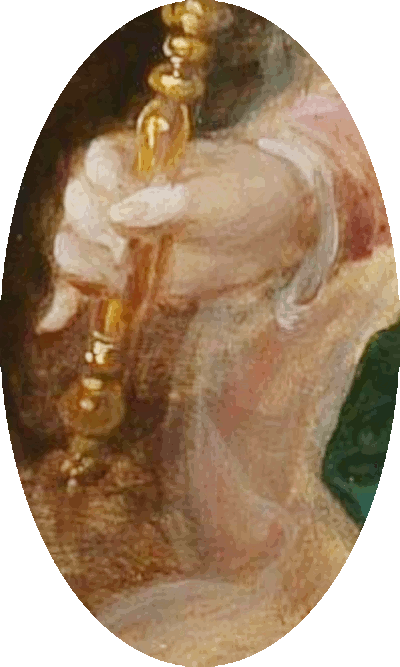
Heavy hand |
- Contrary to the rest of the continent, the Protestant
Reformation never made significant progress in Spain during
Philip V's reign.
- He was a fervent defender of
Catholicism and he considered himself God's armed hand on
earth.
- However, that did not prevent the Spanish Inquisition from holding multiple trials, confiscating the wealth of many suspects, and burning
quite a few at the stake.
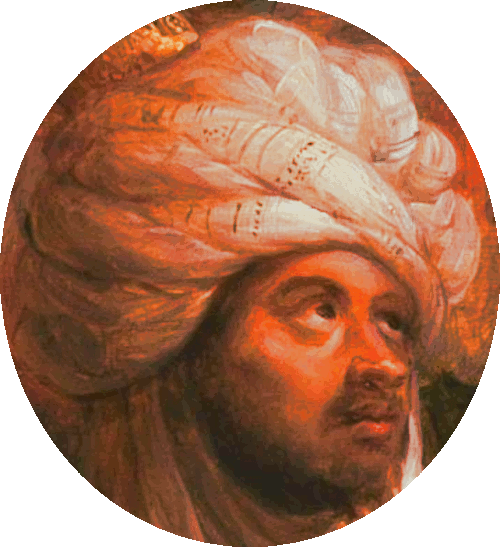
Muslims were persecuted |
- Philip II did not bring that tribunal to Spain, but he gave it royal suppor
and it reached its peak during his reign.
- During the Inquistion, the church persecuted all those who were
trying to hide their true religion as Jewish, Muslim or
Protestant because they were considered heretics and
infidels.
- Rebellion was answered with bloodshed, and the long-drawn-out conflict resulted in a great deal of loss of life due to executions for religious reasons as well as war casualties.
|
For his entire reign, Philip was at war with the Low Countries. This was a crisis of Philip’s own making. Protestant revolt began in 1566 and he would not accept religious compromise in any form. He wanted to crush Protestantism but this strategy was never going to be successful.
Protestant writers and historians blackened Philip’s
name, resulting in him becoming the arch-villain of
the Reformation.
(Susan Abernethy)
|
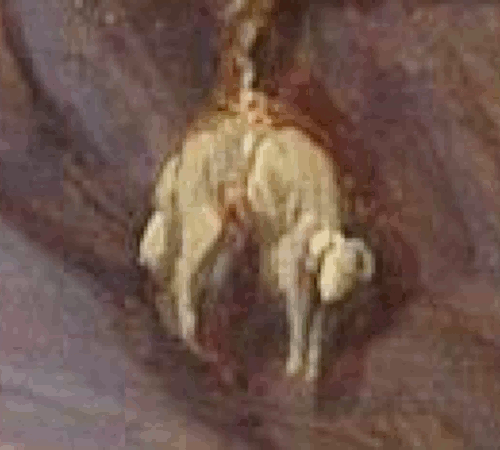
Hanging the she-wolf
Worn by Charles V,
Ferdinand I and Philip II |
-
The Netherlands was Philip’s wealthiest province, and the potential source of most of his taxes,
but it was also the place that most stubbornly clinged to the
Protestant creed.
- His envoy, the Duke of Alba, mercilessly terrorized and executed the Dutch
and in the end they resisted the forceful adoption of the Catholic religion.
- The she-wolf (lupa in Latin) was an Italian wolf who nursed and sheltered the twins Romulus and Remus after they were abandoned in the wild.
|
The 1943 She-Wolf painting by Jackson Pollock refers
to a painting of a female wolf, likely inspired by
Roman mythology, where a she-wolf suckled the twin
founders of Rome, Romulus and Remus. The she-wolf is a
symbol of fertility and the Great Mother archetype,
according to Jungian psychology which reflects the
maternal aspect of the female psyche in its many
forms.
(Assistant)
|
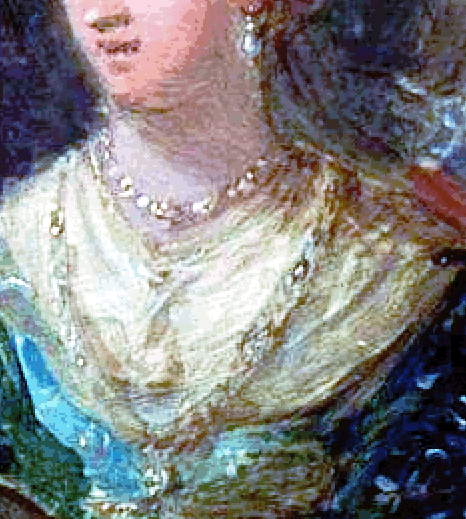
Maria Manuela of Portugal |
- In 1540, Philip was married to Maria Manuela, daughter of King John III of Portugal and Catherine of Spain who was his father’s sister.
- The match was an attempt to bring the last independent kingdom on the Iberian Peninsula under Spanish rule.
- Maria died after giving birth to her first child, a son named Carlos after his grandfather.
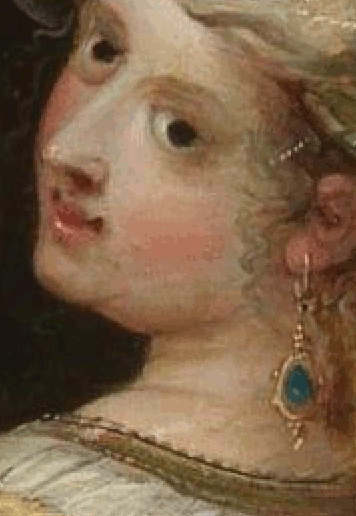
Queen
Bloody Mary I of England |
- For a brief four year period, he was
married to Queen Mary I of England, and therefore, Philip II was nominally king of that country as well.
- Mary Tudor (1516-1558) was the daughter of Henry VIII and his first
wife, Catherine of Aragon.
- She was Queen of England and Ireland from July 1553 and Queen of Spain as the wife of Philip II from January 1556 until her death in 1558.
- The purpose of the alliance was two-fold: to return England to Catholicism and to maintain links between Spain and Charles’ northern dominions.
-
Philip II would have no proprietary rights to the throne if the union was childless.
|
She made vigorous attempts to reverse the English Reformation, which had begun during the reign of her father, King Henry VIII. Her attempt to restore to the Church the property confiscated in the previous two reigns was largely thwarted by Parliament but, during her five-year reign, more than 280 religious dissenters were burned at the stake in what became known as the Marian persecutions, leading later commentators to label her "Bloody Mary".
(Wikipedia)
|
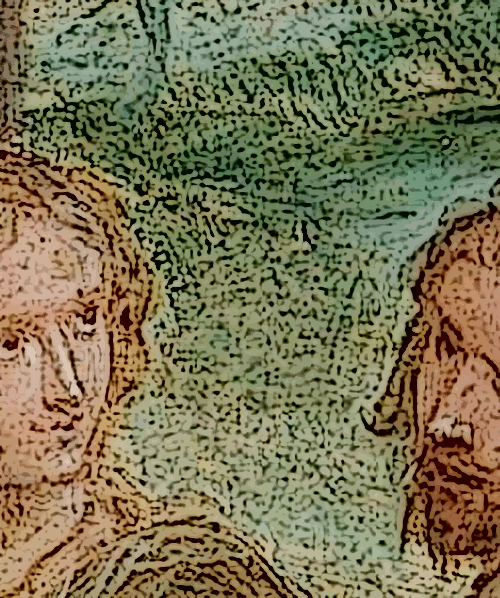
Queen Mary I abandoned |
- In the beginning of 1554, Philip received a copy of the treaty and he was extremely dissatisfied
because the usual privileges due to a husband were denied to him, forcing him to share his wife with England.
- He protected Princess Elizabeth (future Elizabeth I) from
an overthrow by France and did restore some unity between
Rome and the British nobility.
- In the end, the British
Parliament would not give him the authority he desired, and
after Mary I miscarried and gave up hope of having a child,
he abandoned her and went back to Spain.

Sunk |
- In the summer, England was beset by a pandemic of flu and Mary became ill
and it was apparent she was dying.
- Philip concentrated his efforts on making sure there was a smooth transfer of power from
Bloody Mary to Elizabeth
(I) as he feared an attempt to take the English throne by the French-backed Mary Queen of Scots.
- A proposal of marriage from Philip II to future Queen of
England, Elizabeth, occurred either before or shortly after Mary’s death in November.
- Elizabeth never gave a formal, definitive reply to Philip
II,
she was disinterested and he was a total cad to her sister
Mary.
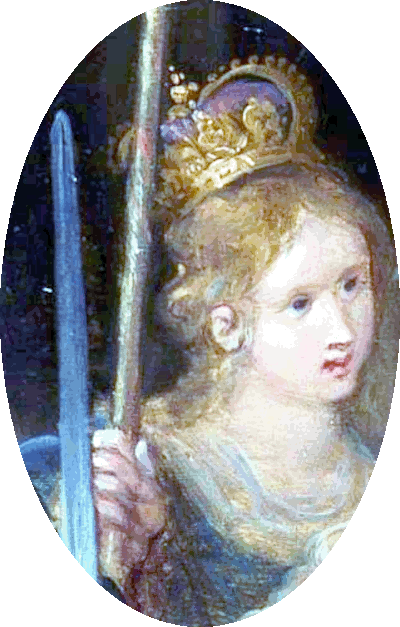
Elisabeth de Valois |
- After the victory at St. Quentin, the Treaty of Cateau-Cambrésis was negotiated with France, leading to a lasting peace between the two countries until 1596.
- The terms of the treaty required Philip II to marry Elisabeth de Valois, the daughter of Henri II and Catherine de’Medici.
- They were married in Spain on June 22, 1559.
-
Valois of the lineage of Mary Magdalene.
|
I assembled my navy to fight the English, not to confront the heavens!
(Philip II)
|
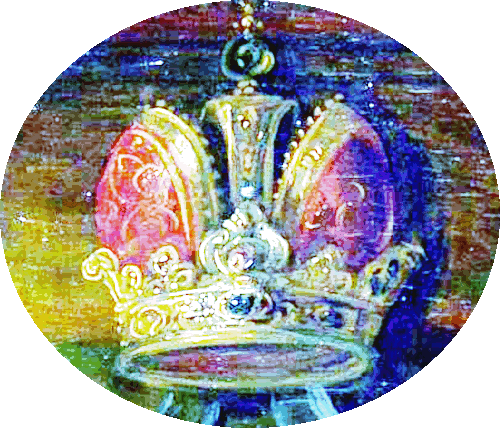
Crown jewels |
- Elisabeth was a Protestant, and Philip II initially maintained peace hoping that the Catholic Mary
Queen of Scots might succeed her.
- War with Spain became inevitable and Philip II armed the most impressive fleet of his
day and sent the
'Invincible Armada' to confront the British Navy and invade
England.
|
After the unexpected death of Henri II, France would be beleaguered by internal political and religious struggles. Spain began the persecution of non-Catholics with the Inquisition which Philip gave free rein to during his monarchy. He even personally attended several auto-da-fé.
(Susan Abernethy)
|
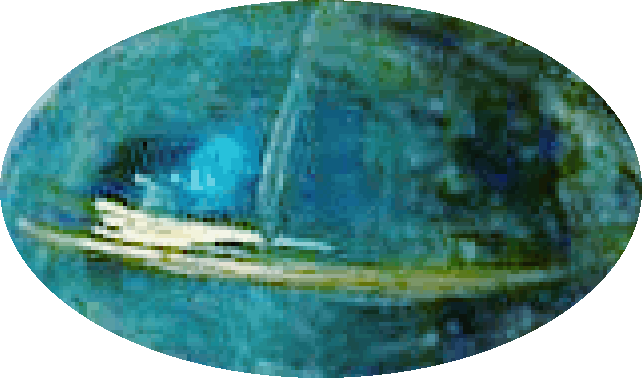
Spanish Armada |
- When Mary Queen of Scots was executed in 1587 on the orders of Elizabeth
I of England, Philip II had his excuse.
- The Spanish Armada sailed with 130 ships which were expected to meet reinforcements in the Low Countries,
however, the weather did not cooperate, cutting the ships off from the shore, prohibiting the rendezvous.
- Strong winds forced the Spanish ships to sail all the
way around the British Isles through the Atlantic Ocean and North
Sea.
- Philip II gave up trying to steal British crowns and
never returned to England.
|
One-third of the Armada was completely wrecked and there was considerable damage and loss of life for Spain. It was a catastrophe and had a considerable psychological impact on the Spanish people and on Philip personally.
(Susan Abernethy)
|
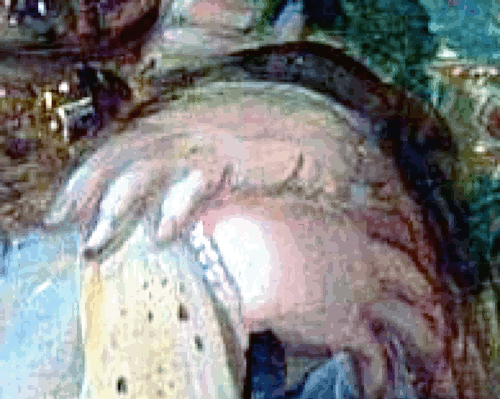
Marriages |
-
The confrontation with France went on multiple fronts, while attempts
at peace
failed.
- Philip II had married the French king’s daughter Elisabeth de Valois, who never
gave him a male successor.
- By the end of his reign, Philip
did manage to hold back the French and prevent three
successive Valois kings from invading the Italian peninsula.
|
Verdi’s opera is based on an imaginary romantic story involving Philip’s son Carlos, in fact the poor man was raving mad.
(Tsuk János)
|
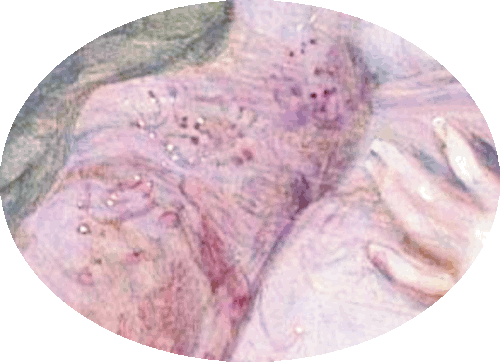
Pregnancy |
- Philip II and Elisabeth had 2 daughters and she died in her
last pregnancy in 1568.
-
It was during this year Philip had to deal with a crisis regarding his eldest son and heir, Don Carlos
who had been born with physical deformities and was never in good health.
- Don Carlos was unstable and subject to violent tempers when he suffered a near fatal fall down some stairs at the age of
17 and he was never the same because he had a brain
injury.
|
Carlos threatened to flee to the Low Countries and join up with his father’s enemies but Philip had him incarcerated. He most likely starved to death but there were rumors at the time that Philip had him murdered.
(Susan Abernethy)
|
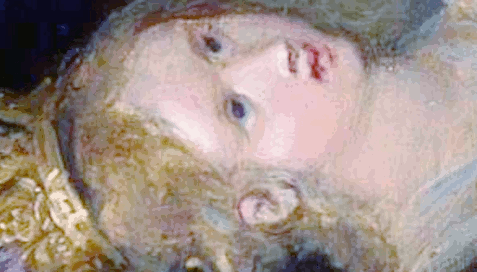
Anna was busy |
- In 1570,
Philip II married his niece Anna of Austria.
- This would be a happy marriage and Anna gave birth to five children, four of which were sons.
- The only child to survive to adulthood was her fourth son who succeeded his father as King Philip III of Spain.
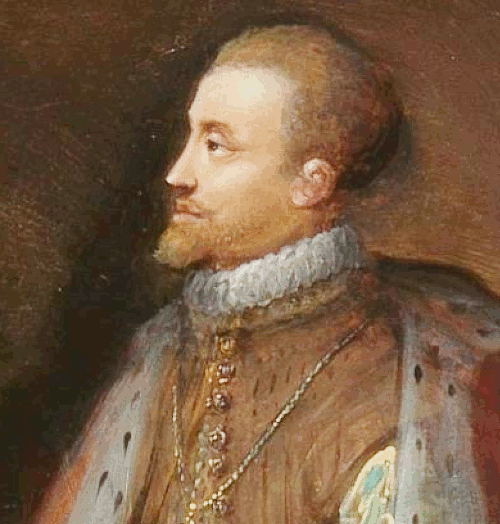
Philip II |
-
The Ottoman navy was initially considered unbeatable and it invaded first the Eastern,
and later the Western Mediterranean, taking Christian slaves and occupying islands
such as Minorca in the Baleares.
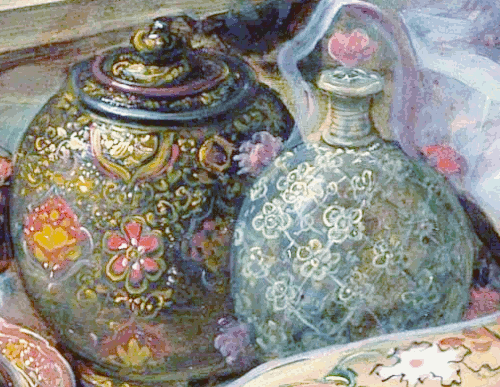
Turkish treasures |
- Finally a joint Papal,
Genoese and Spanish fleet won a decisive victory on October 7, 1571, at the Battle of Lepanto
and more than one-third of the Turkish fleet was destroyed.
- Philip’s half brother played a decisive role in the
victory and Philip covered him with praise, but out of jealousy
never let him lead another military operation.
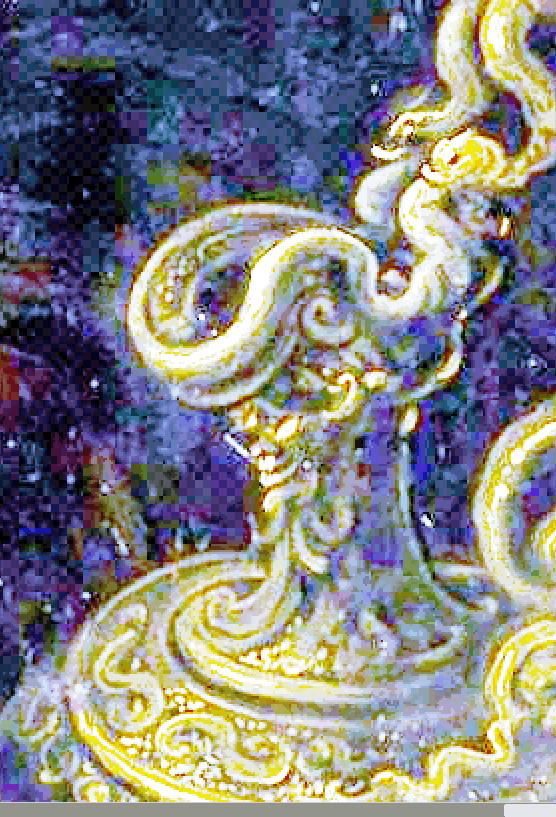
Philip II treasure |
-
In 1580, Portugal fell into a dynastic crisis.
- There were three contenders for the throne including Philip
II who had a claim through his mother.
- Philip II claimed
his right to the Portuguese throne as the grandson of King
Manuel I uniting two of the world's greatest powers.
-
With an army led by the Duke of Alba, he defeated the forces
of Dom Antonio.
- He managed to incorporate the Portuguese monarchy into his empire, giving him increased naval capacity and access to the flow of bullion from Spanish America.
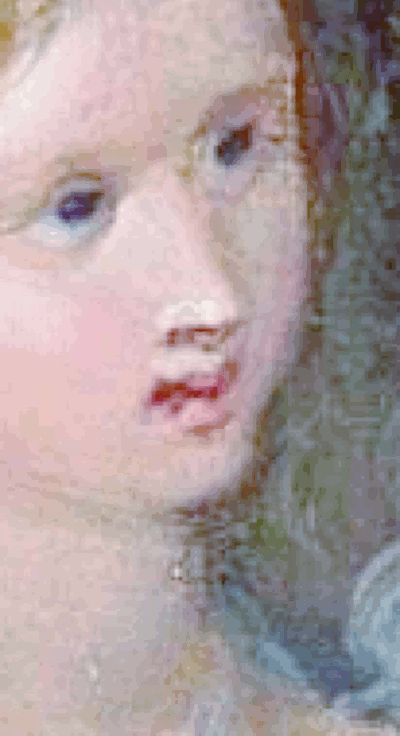
Queen Elizabeth I |
- Meanwhile, in England, Queen Elizabeth I and her advisers
were alarmed by all the Spanish interference.
- They
didn't want the Dutch subjected to Spanish rule and agreed to support the Protestants and encourage Dutch resistance.
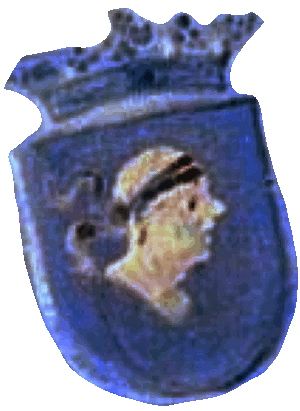
English pirates |
- English pirates were attacking Spanish ships sailing to and from the New World.
- Spain recognized England as its principal maritime rival,
next to Holland.
- Philip II made it his mission to pursue a hostile policy and subjugate England.
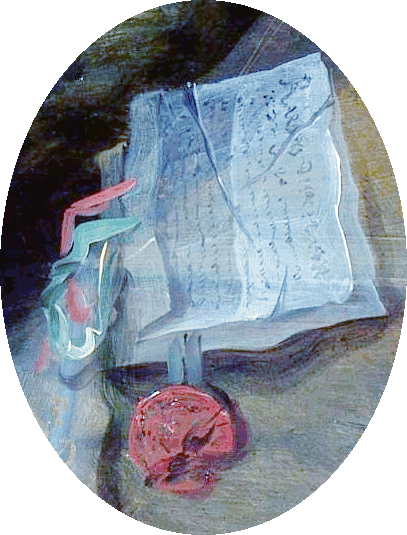
Bureaucrat
and king of papers |
- Philip II was at ease when writing, much less so when talking or needing the assent of his listeners.
- His profession was paper shuffling, correspondence, diplomacy and administration and all of his work was done from behind a desk.
- Although he was prodigious in carrying out his duties, no matter how hard he worked, it was inadequate for the massive task.
- He spent hours in his study meticuously documenting every
aspect of his empire's governance.
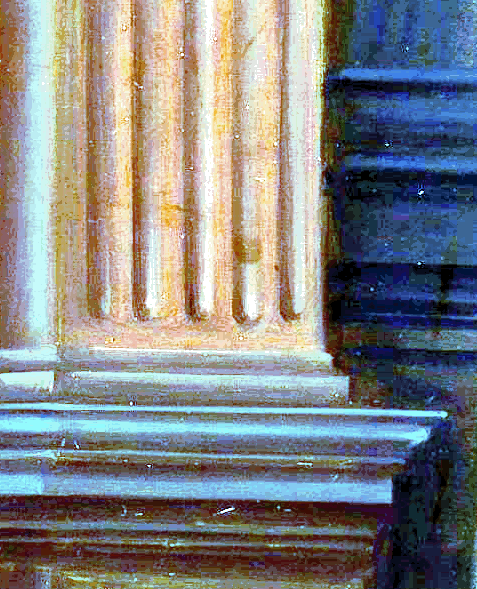
Royal Library |
- One of his greatest
projects was the construction of the Monastery at San Lorenzo de El Escorial
near Madrid.
- Especially remarkable is the Royal Library, inside the Monastery.
- But it was also a mausoleum and palace and perfect symbolism
for a king who saw his power as an extension of divine will.
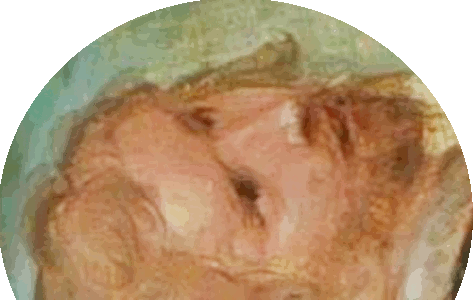
Unhealthy |
- Philip II was never very healthy and since his youth he
suffered from cronic gout which is called 'king's' disease
because it comes from eating rich diets with a lot of meat and
red wine.
- At the age of 63, in 1590, his health began to
deteriorate and besides gout, he suffered from fever spikes
associated with malaria every 3 days.
- He also developed
severe edema which is the accumulation of fluid that left him
with painful swollen legs.
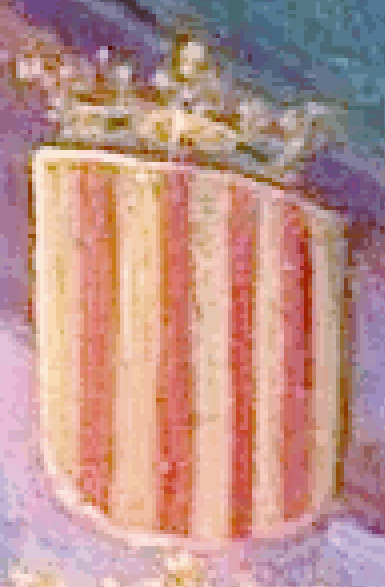
Royal prisoner |
- Philip II was now a prisoner of his own body and by 1596
he could barely write, his hands were so deformed from gout.
- A man who had been in control of half the world now could
barely control his most basic bodily functions.
- In July
1598, Philip II's condition worsened dramatically and the
edema had spread throughout his body causing excruciating
pain.
- Gout had spread from not only his hands and feet,
but also his knees, elbows and spine.
- The royal
physicians were powerless in such suffering, and they resorted
to bloodletting and purges that only weakened him further.
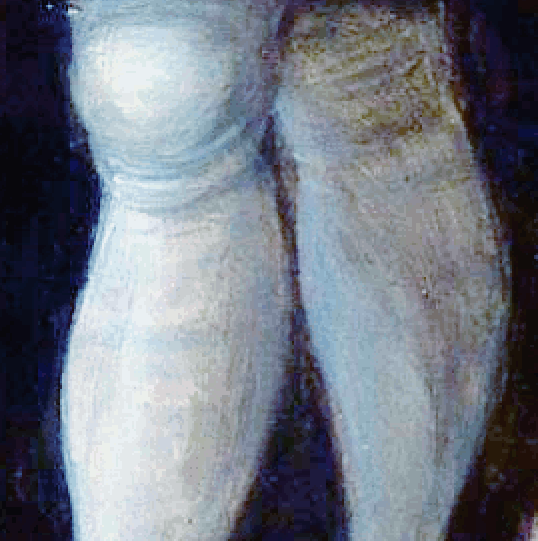
Edema swell |
- The fever did not subside and Philip II alternated
between delirium and lucidity and permanently confined to bed,
he developed deep bed sores that became infected.
- His
deep wounds from the sores covered his body, and he developed
lice and was unable to defend himself against the smallest
creatures.
- Holes had to be cut into his mattress to
relieve his body fluids because he was trapped in his bed.
- For a deeply religious man, the degradation of his body also
represented a spiritual trial, and he viewed his suffering as
an anticipated purgatory, an expiation of his sins before
death.
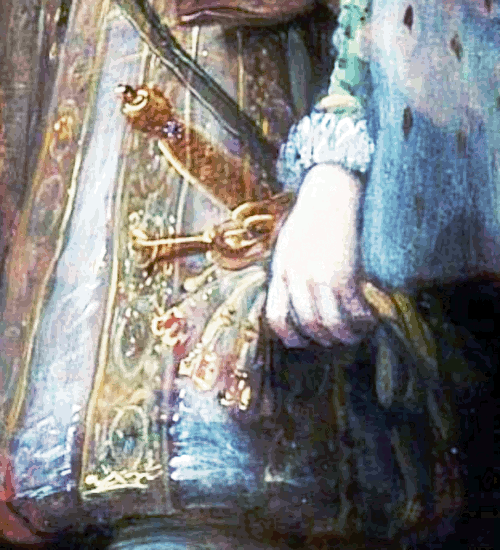
Philip II regalia |
- After 52 days of uninterrupted agony, at dawn on September
13, 1598, he passed at age 71.
- When Philip
II died, after a reign of over half a century, few of his subjects regretted his
passing.
-
Philip fought on all the fronts he inherited from his father, bearing a burden that was too heavy for him, he was clearly overextended both militarily and financially.
- He was a king who had spent his life expanding and
preserving Catholicism, who sent the Spanish Armada against
England, suppressed revolts in the Netherlands, and unified
Portugal and Spain.

Too nany subjects |
- Philip II refused to delegate authority and would fall further and further behind each year.
- He felt that he had received absolute power from the Almighty and he was only responsible
for only what was in front of him.
- There is a sharp
constrast in his demise, from how he believed he lived his
life.
- His subjects began to wonder if a king, appointed
by God, could suffer in such a painful and humiliating way,
what did this say about the divine order that supposedly
governed the world.
- This was a blow to the perceptions of
power and divinity in that period.
|
Philip had a strong and devoted sense of duty and personal responsibility. Whereas his father had been a military and cavalier king, Philip was a bureaucrat. He did not lead his armies and never did enjoy the hunt.
(Susan Abernethy)
|
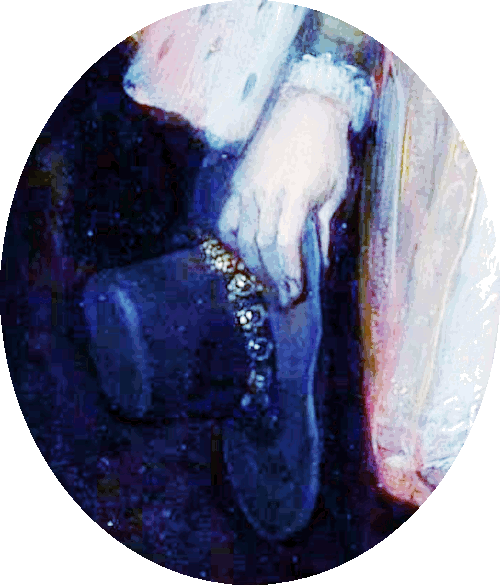
Hangs up the royal bolero
Which is very
Catholic |
- During his reign, he tried to control everything; politics,
religion, culture, the seas, and many distant territories.
- He built a bureaucratic system so detailed that nothing
escaped his attention.
- Some historians wonder if his
declining health the last decade of his life, a period he had
to rely on relatives and advisors to rule for him, caused the
military and economic setbacks that Spain began to suffer.
- Also, that his sickness created an obstinacy that made him
more inclined to seek peace as seen in some treaties than he
would in previous years.
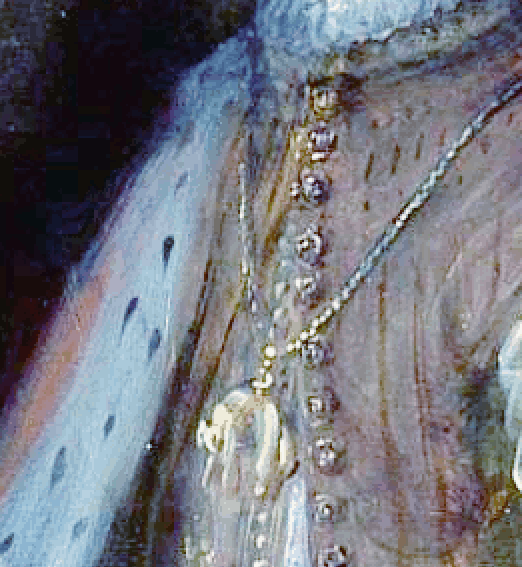
Philip III |
- Bad luck followed him until the end
and in the year of his death the harvest failed and the plague hit Madrid.
- His son, Philip III, inherited an empire that was still
vast, but was already showing the first signs of the long
decline that would mark the next century.
- Unlike his
father, Philip III was not a meticulous administrator and he
delegated much of the government to his favorites.
-
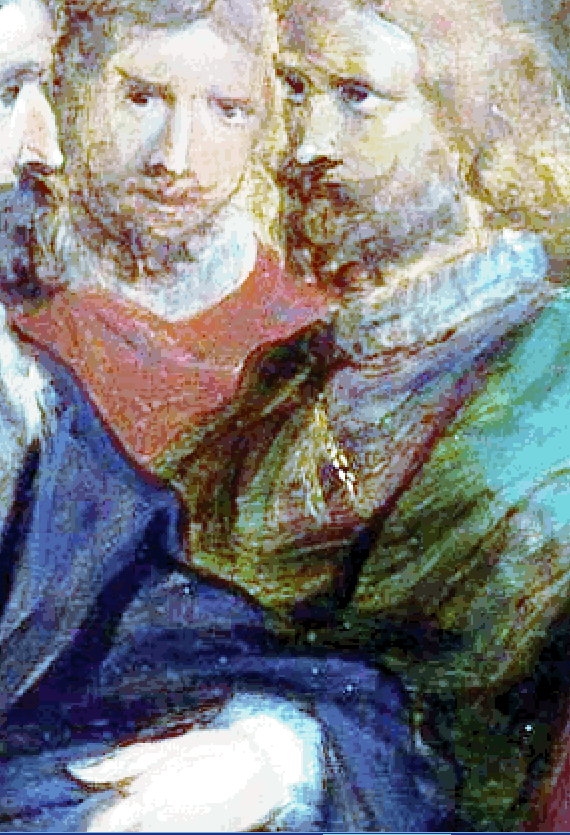
Gene pool carrys on |
-
Cooperation between imperial and Spanish Habsburgs in the 17th-century failed to maintain the hegemony that the dynasty had enjoyed in the 16th-century.
- For the imperial line, religious troubles in Germany and in central Europe went on.
- The Bohemian insurrection of 1618 gave rise to that chain of wars involving the Austrian Habsburgs that, because it was prolonged until 1648, is known conventionally as the Thirty Years’ War.
- Ferdinand’s male descendants were Holy Roman Emperors until 1740, Philip’s were kings of Spain until 1700.
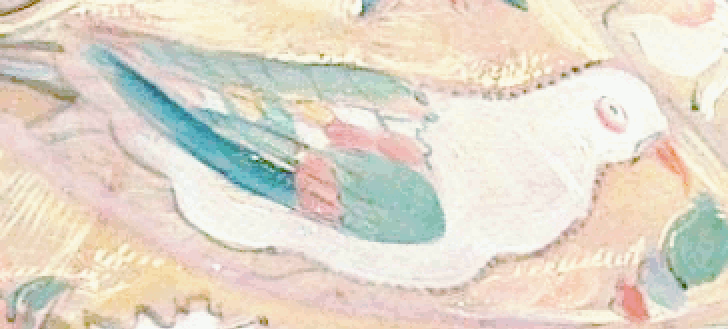
Roman dove |
- In Roman culture, doves were associated with the goddess Venus (Aphrodite in Greek), who represented love and beauty.
- They were also seen as omens, and their flight could be interpreted as a positive sign.
-
Romans also used pigeons for communication, including sending dyed pigeons to inform chariot racing owners of the results.
|
Doves, particularly white doves, often symbolized peace and were incorporated into Christian art, especially in funerary depictions of a dove carrying an olive branch, signifying peace.
(Assistant)
|
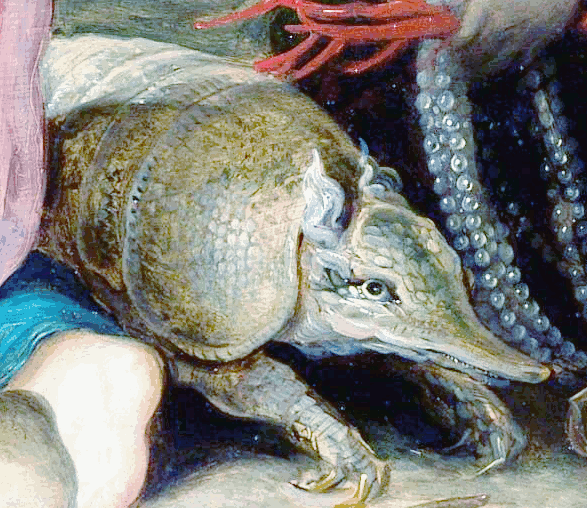
Germanic armadillo |
- The name armadillo, or
'little armored thing' originated from the Spanish conquistadores.
- Aztec name was Azotochtli, which means
'turtle-rabbit.'
- There's two legit reasons why Dracula would have armadillos.
- They were another eccentric sign of wealth, and armadillos were only found in the southwestern US and parts of
Central or South America.
- Dracula would have had to
have his subjects deliver them to his castle.
|
Known for its protective shell, this creature offers profound insights into defense mechanisms and vulnerability. It stands as a powerful emblem of how we guard ourselves and the importance of setting healthy boundaries.
(Ammie Gibson)
|
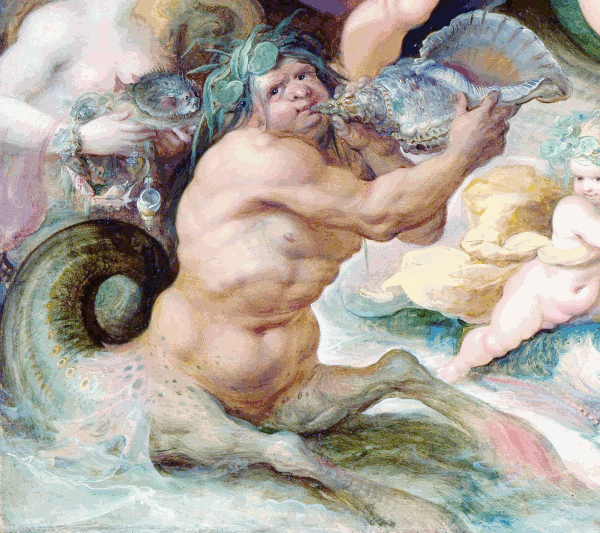
Ichthyocentaurs |
- Centaurs, like Chiron, were creatures with the upper body of a human and the lower body of a horse.
- Ichthyocentaurs, on the other hand, were a mix of human, horse, and fish, with the posterior half of their body resembling a fish tail.
- They are associated with the sea and are sometimes depicted with a conch shell.
- Triton was a Greek god of the sea, a merman (human upper body, fish tail) who often blew a conch shell.
|
These were sea-dwelling beings, often depicted as peaceful rulers or assistants in the sea, and were associated with the birth of Aphrodite and the governance of Carthage.
(Assistant)
|
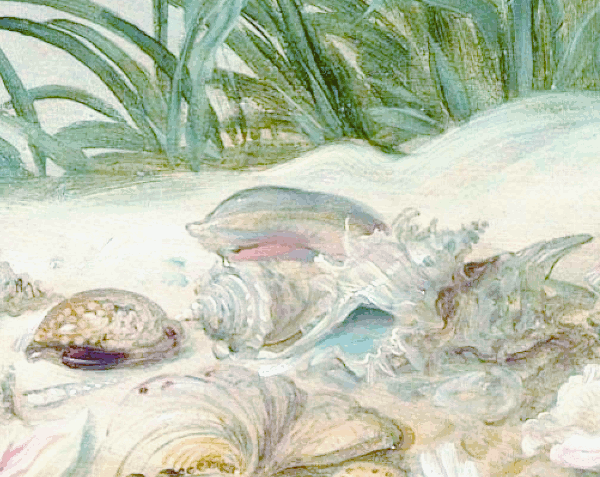
Beach and seashells |
-
In Roman culture, seashells held symbolic and practical significance
as they were associated with fertility, particularly with the goddess Venus (Roman equivalent of Aphrodite).
- Emperor Caligula had a symbolic collection of seashells, which he claimed as
'spoils of war' after a planned invasion of Britain was abandoned.
- Seashells were also used as containers for Roman cosmetics and
as kitchen tools.
- They were a favored decorative feature in Greco-Roman times, appearing in art, architecture, and even furniture
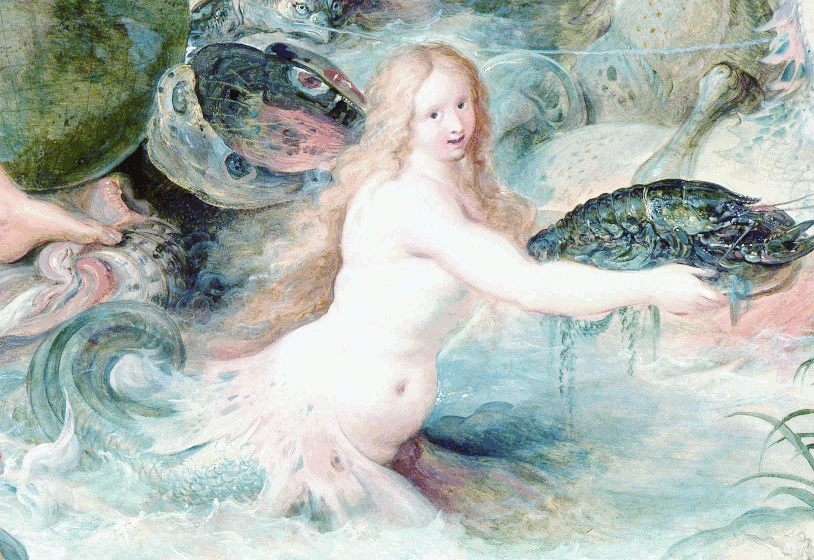
Mermaid |
-
The Roman Empire didn't have a specific term for 'mermaid' in the modern sense, they certainly had mythological figures and beliefs that included sea creatures and beings with aquatic characteristics.
- Also associated with the sea god Neptune and his consort Salacia.
- These maidens often had human-like features and were sometimes described as having fish tails,
hence the concept of a mermaid.
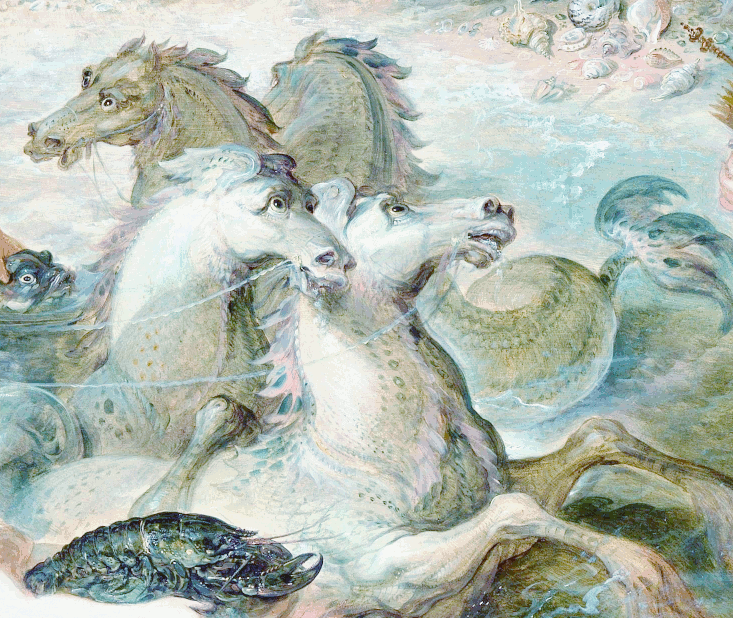
Philip II and Ferdinand I carry on |
-
In Roman art and mythology, the seahorse, or hippocampus, was a mythical creature depicted as half-horse, half-fish.
- It was often associated with Neptune, the Roman god of the sea, and was depicted pulling his chariot.
- Hippocampi were also believed to be the fastest creatures in the ocean, making them the favorite steeds of Neptune,
who is Poseidon in Greek mythology.
|
I speak Spanish to God, Italien to women, French to men and German to my horse.
(Charles V)
|
|

